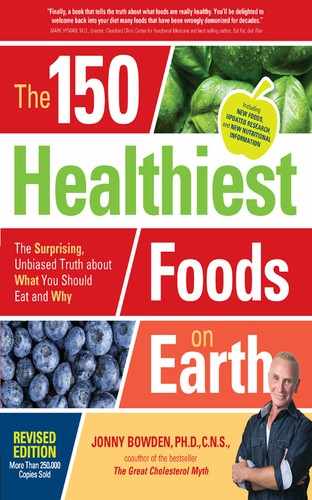
Let’s be clear on one thing: There are no bad fruits.
Fruit has gotten a bad rap from some sections of the low-carb and Paleo community, but I think their assessment of fruit is generally too harsh. Sure there’s sugar in fruit, but it’s bound with fiber, phytonutrients, vitamins, minerals, flavonoids, and all kinds of other good compounds. Unless you’re highly sensitive to sugar of any kind in any amount, most fruits won’t present a problem for you and should be an integral (and delicious) part o a nutritious diet.
Selecting fruits for this book presented a problem that I didn’t encounter in many of the other categories (except vegetables): an embarrassment of riches. The problem wasn’t finding fruits that belong on the list, it was eliminating worthy contenders to get the list down to manageable proportions.
Of course, some fruits are just absolute superstars and there was never any question that even if there were to be only ten foods on the list, they’d make the cut. Apples and blueberries, for example. And guava. If this list were an all-star basketball team going to the Olympics, they’d be the Kobe Bryants. To continue the analogy, we also found some good utility players that, while terrific, wouldn’t have made a short list of Olympic contenders. The star fruit, for example, is not quite as loaded with nutrients as some of the winners, plus it’s harder to find and smaller in size. Star fruits went on the runners-up list.
Why Some Fruits Didn’t Make the Cut
Sometimes the selection process had to do with convenience, and sometimes the decision considered whether the fruit was most commonly available. And, sometimes, things change. For example, pomegranate is a great fruit, but it takes a lot of work to eat it, and the edible part of the fruit is small. So when the first edition of this book came out, pomegranate seeds didn’t make the cut, but the widely available pomegranate juice did. Since the publication of the first edition, that’s no longer the case. Pomegranate seeds have become widely available at grocery stores such as Trader Joe’s and Whole Foods. The work is done for you—they dig out all the edible, delicious seeds from the inedible pulp, and then package them in a little plastic container. They’re expensive, but they’re fantastic. I highly recommended them if you don’t mind spending a little extra for the convenience of not having to dig the seeds out of the fruit.
Noni and acai berries also presented a couple of problems. The noni berry tastes terrible (but the juice does not—see here); plus, you can’t find the berry itself anywhere but the tropics. The acai berry used to be only available in Brazil, but since the publication of this book you can now find them in the United States, and acai juice products can be found everywhere. The goji berry (see here) originally made its way to the United States in both berry and juice form. I decided to include the whole goji berry on the list because space was limited and the juice isn’t as well known or widely available.
Although the mantra “eat more fruits and vegetables” has been repeated so often it’s become a cliché, it’s worth pointing out that fruits and vegetables as categories are quite distinct from a blood sugar point of view. If you forced me to choose one of the two categories, it would be no contest: Vegetables are the clear winner. That’s because fruit—wonderful though it is—does have more sugar and has the potential to play havoc with both blood sugar and insulin. For this reason, there are dietary programs (for example, most low-carb programs) that don’t allow fruit at all during the first few weeks. Almost all the nutrients found in fruits are obtainable in vegetables, and with substantially less impact on blood sugar.
High Blood Sugar? You Can Still Eat Fruit
Does this mean that people watching their weight or their blood sugar should avoid fruit? Not at all. But if you’re in that category, fruit is not an unlimited item. Much has been written about the sugar impact of fruits, and if you’re concerned about sugar, or if weight, diabetes, or metabolic syndrome are issues for you, it would be wise to read more about on the subject of glycemic index and glycemic load. (See the introduction to this book, shown here, for more information.)
If you’re not overweight and don’t have issues with blood sugar, there are no concerns about fruit at all. Eat it, juice it, consume it raw or cooked, just make it a part of your daily routine (along, of course, with tons of vegetables).
The ancient Greek aphorism “Know thyself” was inscribed in golden letters at the entrance to the Temple of Apollo at Delphi. It’s as true now as it was then. Some people are more sensitive to sugar than others. That’s just how it is. To quote Shakespeare, “To thine own self be true”—it’s the key to making good choices in food as well as good choices in life.
Apples

“An apple a day keeps the doctor away” is a good example of one of those old clichés that actually turns out to be right. Researchers at Oxford University found out that eating even one medium-sized apple a day (or a handful of fresh strawberries) could slash heart disease risk by an impressive 40 percent.
Apples have certainly rehabilitated their image since first becoming known as the little fruit that brought down the Garden of Eden. Their résumé of health benefits could easily fill a book. Epidemiological studies have linked the consumption of apples with reduced risk of some cancers, cardiovascular disease, asthma, and diabetes. And that’s just for openers.
Apples contain quercetin, a flavonoid that, in a 2001 Mayo Clinic study, helped prevent the growth of prostate cancer cells. Another study, at Cornell University, showed that phytochemicals in the skin of an apple inhibited the reproduction of colon cancer cells by 43 percent. And the National Cancer Institute reported that foods containing flavonoids may reduce the risk of lung cancer by as much as 50 percent.
Apples’ Antioxidant Power
But wait, there’s more!
Apples contain a host of phytochemicals, including quercetin, catechin, phloridzin, and chlorogenic acid. So what does that mean for you? Strong—really strong—antioxidant power. Since both cardiovascular disease and cancer are thought to be highly related to what’s called oxidative stress (the damage done to cells and DNA by oxidation), the ability to fight off the destructive effects of that oxidation is a major weapon in the healing power of any food. Apples have that antioxidant power in spades. In fact, apples have the second highest level of antioxidant activity of any other commonly consumed fruit in the United States (beaten out only by cranberries).
Apples are also high in phenolic compounds, a huge class of biochemically active substances most of which belong to the flavonoid group. There are literally thousands of flavonoids, but all you really need to know about them is this: they are really, really good for you. And compared to every other fruit, apples have the highest portion of free phenolics. While that may sound like the phenolics just got out of prison, it means they’re not attached to other compounds in the fruit, which in turn means they’re more available for absorption into your bloodstream, where they can go to work providing you with all the amazing health benefits and cancer-fighting ability they have to offer.
Apple Eaters Enjoy a Lower Risk of Tumors, Lung Cancer, and Cardiovascular Problems
Now we already know from a zillion studies that eating more fruits and vegetables helps protect against a host of diseases. In data involving 34,467 women in the Nurses’ Health Study, frequent consumption of fruit in general was found to be associated with a significant reduction in the risk of developing colorectal adenomas (benign tumors).
It’s not often, however, that the individual fruits or vegetables are examined for their impact. But in the Nurses’ Health Study and the Health Professionals Follow-up Study, women who consumed at least one serving per day of apples and pears had a reduced risk of lung cancer. In a study conducted in Hawaii, there was a 40 to 50 percent decreased risk in lung cancer in participants with the highest intake of apples, onions, and white grapefruit. Other studies have also shown a relationship between flavonoid intake—particularly quercetin—and the development of cancer. And in the Women’s Health Study, the women ingesting the highest amounts of flavonoids had a 35 percent reduction in the risk of cardiovascular events.
Apple consumption has been inversely linked with asthma (the more apples, the less asthma). And apples may also be associated with a lower risk for diabetes. In a study in Finland, apple consumption was associated with a reduced risk of type 2 diabetes, and in a study in Brazil it was associated with weight loss.
Apples contain pectin, a valuable source of soluble fiber that can lower LDL cholesterol and help regulate blood sugar. Speaking of sugar: Yes, apples do have some sugar (fructose), but I wouldn’t worry about it (unless you are a diabetic or have serious blood sugar challenges). The sugar in apples come wrapped with 5 g of fiber and a rich blend of nutrients, very different from the high-fructose corn syrup used to sweeten every junk food on the market. And one study, by Silvina Lotito, Ph.D. of the Linus Pauling Institute, suggests that the fructose in apples might even turn out to be responsible for some of the apple’s health benefits.
Osteoporosis and Apples
Oh yes, one more thing. No one ever seems to mention this, but apples are one of the best dietary sources of boron. Boron is a mineral that has real bone-building properties, and it is an important part of an osteoporosis prevention program. An article in the Journal of Applied Nutrition by Rex E. Newnham, Ph.D., D.O., demonstrated a high probability that there’s a connection between not having enough boron in your system and having symptoms of arthritis. This arthritis-boron connection was observed in various populations around the world. Boron also seems to be energizing.
My friend John Hernandez, M.D., director of the Center for Health and Integration in San Antonio, Texas, tells of a study in which drowsy college sophomores were given supplements of 3 mg of boron—all of a sudden, no more falling asleep in class. Sure, it’s anecdotal evidence, but clinical experience should never be ignored just because it’s not a randomized clinical trial. My nutrition mentor, the late great Robert Crayhon, used to say that the New York City fire department didn’t have a single randomized trial to show that water puts out fire, but they observed that it worked!
The Best Apple of All
By the way, when you eat (or juice) apples, don’t forget the peel. Apple peels have been found to have potent antioxidant activity, and they can greatly inhibit the growth of liver cancer and colon cancer cells. Though almost all apples contain valuable phenols and antioxidants, the good old Red Delicious seems to frequently come out the winner when it comes to antioxidant power.
Apricots
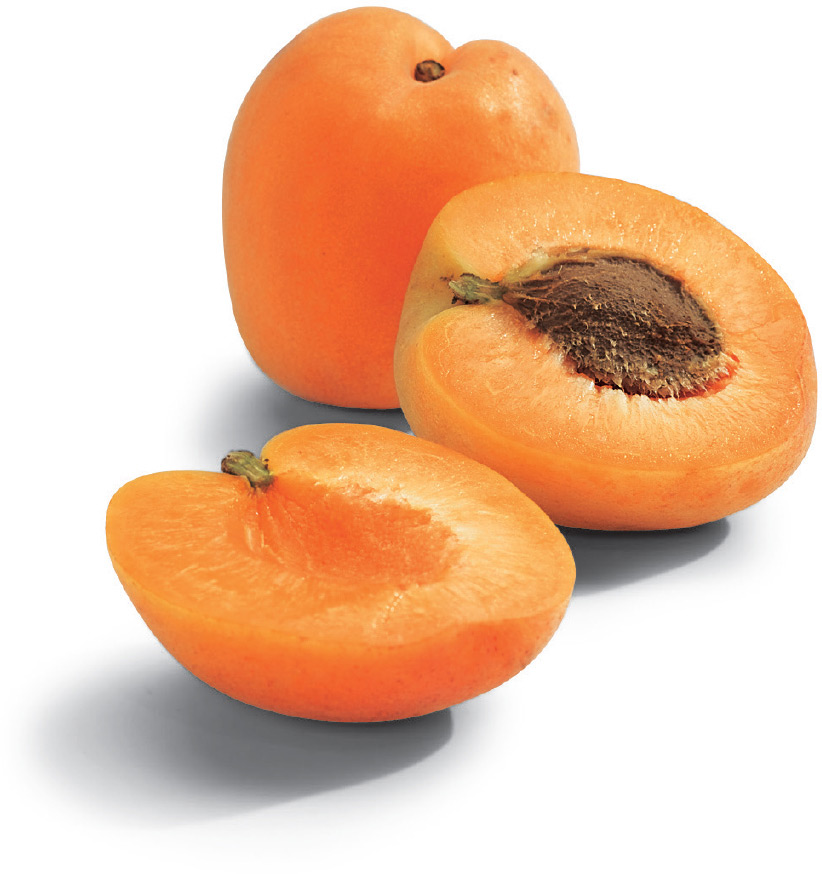
An apricot is basically a tasty little low-calorie bundle of nutrients put together in a beautiful, sun-colored package. What’s not to like?
Two medium apricots have about 11/2g of fiber, 1,348 IUs of vitamin A, 766 IUs of beta-carotene, 181 mg of potassium, and, just for good measure, 13 mg of phytosterols, plant chemicals that have numerous health benefits. Apricots also contain beta-cryptoxanthin, a member of the carotenoid family that is a strong antioxidant and seems to reduce the risk of lung and colon cancer.
Some studies have demonstrated that beta-cryptoxanthin can reduce the risk of lung cancer by more than 30 percent, and other studies have shown that it reduces the risk for arthritis as well. To absorb the beta-cryptoxanthin, it’s essential that your diet contains some fat, since, like other carotenoids, beta-cryptoxanthin is fat soluble. That makes a pretty strong argument for apricots and almonds as a healthy treat, don’t you think?
The apricot originally hails from China, where it has been grown for more than 4,000 years. Legend has it that it was brought to the West by Alexander the Great. Most of the apricots in the United States are grown in California, but many varieties come from the Middle and Near East, especially Turkey. I remember that one of the first natural food stores I ever patronized was owned by a Turkish family who were especially proud of their imported, high-nutrient, fresh apricots.
What about Dried or Stewed Apricots?
Dried apricots are a favorite health food, and they are frequently found in trail mixes. They’re a little high in sugar since they’re so concentrated. Dried apricots are also higher in calories (1/2 cup [65 g] of dried apricots has 157 calories vs. 34 for two small whole apricots). And, for some strange reason, you lose the beta-cryptoxanthin in the dried version. But they’re still a good source of beta-carotene and vitamin A.
Another option is stewed apricots (106 calories for 1/2 cup of stewed fruit, unsweetened). They’re delicious, even higher in potassium and fiber, and still loaded with beta-carotene and vitamin A. No beta-cryptoxanthin, though—for that, you need to eat the whole fruit raw.
 Avocados
Avocados
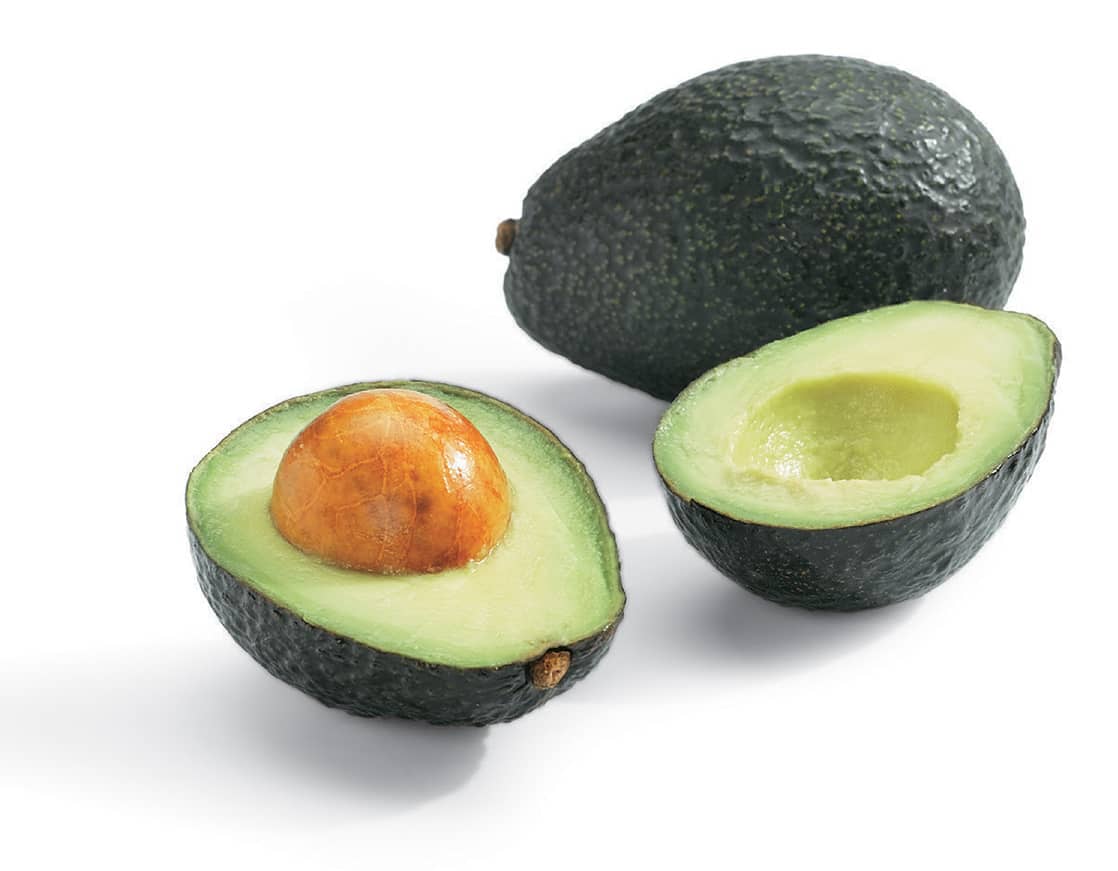
Avocados are an amazing food. In 2016, when Steven Masley, M.D., and I published Smart Fat: Eat More Fat, Lose More Weight, Get Healthy Now, we put an avocado on the cover. It’s the poster child for a healthy high-fat food.
But the luscious avocado was not always held in high regard. Avocados were almost a casualty of the fat phobia that swept the nation back in the 1980s—and is sadly still very much with us. I’m counting the days until fat phobia dies a much-deserved death, and there are promising signs that it’s starting to happen. That’s very good news for those of us trying to redeem the reputation of this (and other) glorious high-fat foods that are, good for your health.
Why the Fat in Avocados Is Good for You
So yes, avocados are high in fat. But that fat is largely monounsaturated fat, specifically oleic acid, an omega-9 fat found in high amounts in olive oil and many nuts. Monounsaturated fat actually benefits your cholesterol profile. In research at the Instituto Mexicano del Seguro Social in Mexico, forty-five volunteers who ate avocados every day for a week experienced an average 17 percent drop in total blood cholesterol. More important, is the effect avocados had on specific kinds of cholesterol. In the study, both LDL and triglycerides went down, while HDL—which is mostly protective—went up.
Monounsaturated fat like the kind found in avocados has also been linked to a reduced risk of cancer and diabetes. Research published in the Archives of Internal Medicine and reprinted on the American Diabetes Association website demonstrated that people following a modified low-carb diet higher in monounsaturated fat lost more weight than a matched group of people following the standard National Cholesterol Education Program diet. And monounsaturated fats are a key component of the Mediterranean diet, which in every major study has been linked with lower rates of heart disease.
Great for Eyes, Heart, and Skin!
Avocados also contain lutein, a valuable member of the carotenoid family; it is a natural antioxidant, helps your eyes stay healthy, and helps maintain the health of your skin. According to David Herber, M.D., director of the Center for Human Nutrition at University of California in Los Angeles and one of my favorite nutritionists, “California avocados rank highest in lutein, which acts as an antioxidant, and beta-sitosterol, which blocks cholesterol absorption compared ounce-per-ounce to other fruits. These attributes make the avocado an important fruit to choose, along with other fruits and vegetables, to protect your heart.”
Though there are a few grams of saturated fat in an avocado, it’s precisely the kind of saturated fat I’m not the slightest bit afraid of. It’s from a natural whole food, and quite different from the saturated fat you might find in an order of fries. It doesn’t contain a large helping of toxins like steroids, antibiotics, and bovine growth hormone found in a factory-farmed animal. Good, healthy, natural saturated fat—whether it comes from grass-fed beef or from a delicious avocado—is finally making a comeback. One study in the prestigious American Journal of Clinical Nutrition showed that in postmenopausal women who consumed a reasonable 25-percent-fat diet, a greater amount of monounsaturated fat and a greater amount of saturated fat intake was associated with less progression of coronary atherosclerosis. High-glycemic carbs were associated with a greater progression. This finding lead to the publication of an editorial in the American Journal of Clinical Nutrition entitled, “Saturated Fat Prevents Coronary Artery Disease? An American Paradox.”
I’ll bet you didn’t know that avocados are a great source of fiber. Don’t feel bad—few people do. You’ll get between 11 and 17 g of fiber per avocado!). Avocados are also a good source of potassium. And they contain folate, vitamin A, beta-carotene, and beta-cryptoxanthin, another healthy carotenoid. I frequently eat a whole avocado as a mini-meal right, out of the skin. Couple hundred calories, tons of heart-healthy fat, one-third to one-half of the day’s fiber, plus it’s filling and delicious. And next to zero effect on blood sugar.
Bananas
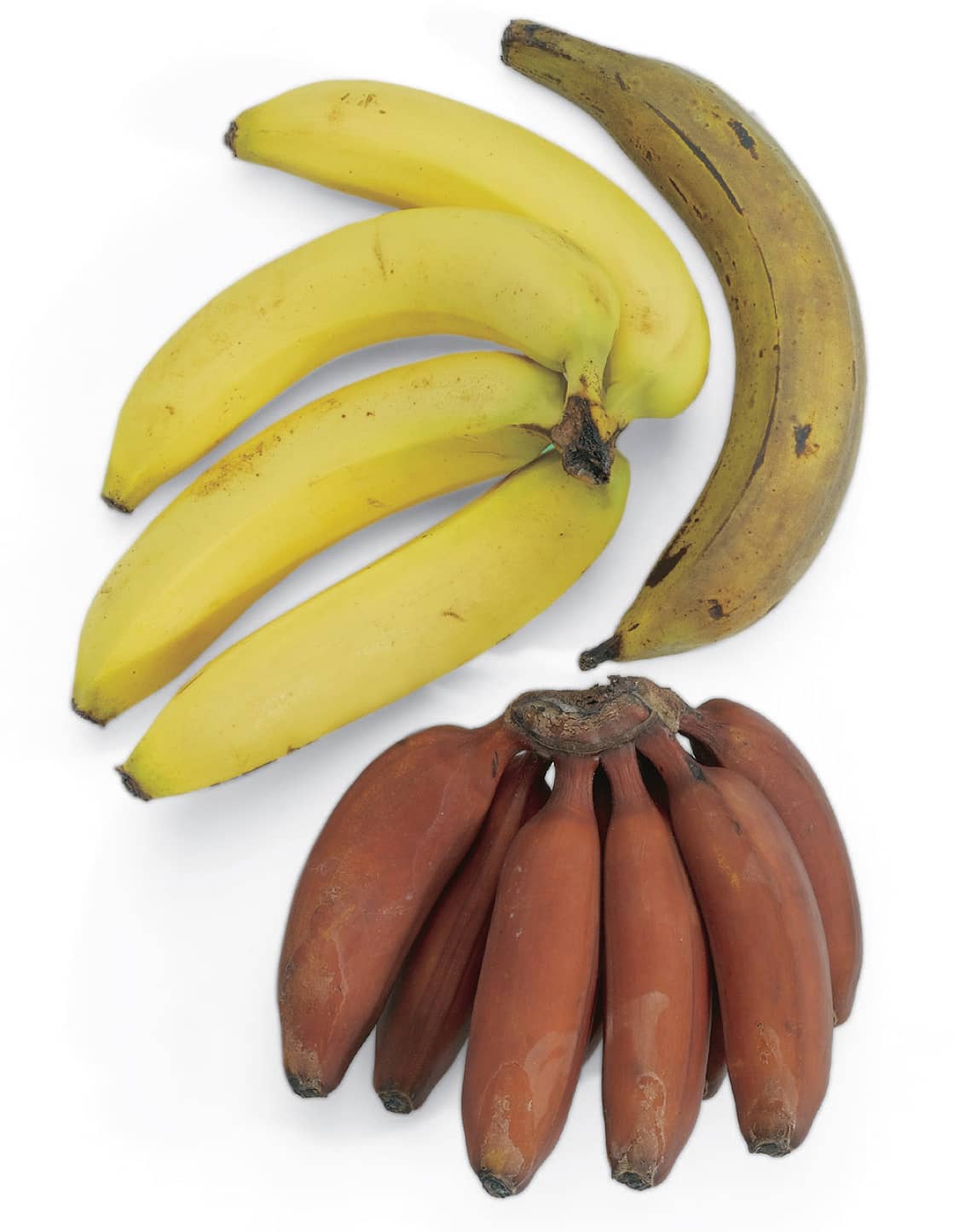
Bananas aren’t necessarily a nutritional heavyweight, but they’re a healthy food. Their main claim to fame is potassium and fiber (more on the fiber part in a minute). And yes, they have a lot of potassium, but they’re hardly the only food source of that important heart-healthy mineral. Calorie for calorie, foods like spinach and broccoli beat the pants off them. So does a cup of baked beans, navy beans, tomato juice, cantaloupe, or two medium kiwifruits.
The Importance of Potassium
Bananas are convenient and relatively low in calories (about 100 calories per banana). The fiber is also a big selling point. And even though other foods may contain just as much potassium, that doesn’t mean the 422 mg of potassium per medium banana is anything to sneeze at. Let’s not forget the major role potassium plays in the body, helping to maintain cell integrity, fluid and electrolyte balance, and, most important, a steady heartbeat!
A drop in potassium levels can make you weak and tired, and low potassium is often connected to muscle cramps. Plus, many health professionals believe that potassium might both prevent and correct hypertension.
An interesting Swedish study on the risk of developing kidney cancer found that regular consumption of specific foods—bananas, root vegetables such as carrots and beets, salad greens, and cabbage—was linked to a 50 to 65 percent decrease in risk for kidney cancer. The study was published in the International Journal of Cancer. Women in the study who ate bananas four to six times a week had about half the risk of kidney cancer as those who didn’t eat them.
The Fiber Connection: Bananas, Fructooligosaccharides and Resistant Starch
In the years since the original publication of this book, there’s been an explosion of research on the microbiome, which is the name given to the huge population of non-human microbes that live in your gut and on your skin. Having a healthy balance of bacteria in your gut is now universally recognized as a vitally important component of human health, affecting everything from mood to weight. But those bacteria are living critters, and they need to eat. That’s where fiber comes in.
Fiber comes in three forms—soluble, insoluble, and something called resistant starch. Bananas are high in a particular form of soluble fiber called fructooligosaccharides. Fructooligosaccharides (FOS) is especially important to us because it’s a prebiotic—meaning it serves as a great food for the good bacteria (probiotics) in your gut. You want to keep the good bacteria in your gut healthy, happy and thriving, and one of the best ways to do that is to feed them a steady supply of prebiotics (like the FOS in bananas).
Unripe bananas are also a good source of resistant starch, which also serves as food for the good-guy microbes. But once the banana starts to ripen, the resistant starch turns into ordinary starch, and goodbye probiotic effect. An unripe banana is kind of the perfect food for gut bacteria, providing a combination of two of their favorite foods—prebiotic fructooligosaccharides and resistant starch.
In one study published in the Journal of Agriculture and Food Chemistry, bananas were hands down the most potent fruit source of fructooligosaccharides. The Jerusalem artichoke (see here) are the most potent source in the vegetable category, followed by onions. And bananas and rice have long been a folk remedy for digestive upset, especially diarrhea.
Not as High in Sugar as You Might Think
Bananas have gotten a bad rep as being a high-sugar food. That’s partly true, but not nearly as bad as people think. The glycemic load of the average banana is 12. Glycemic load is the only measure that really counts when it comes to evaluating a food’s effect on blood sugar. It’s considered low if it’s under 10, medium if it’s 10 to 20, and high if it’s higher than 20. The banana’s rating of 12 puts it right in the low section of the medium category.
I think part of the problem with bananas was that they suffered from guilt by association with the typical 1980s low-fat breakfast that was once considered the epitome of a healthy meal—banana, crummy commercial cereal, skim milk, orange juice, and toast. And yes, we now know that combo is a nightmare from a blood sugar point of view.
But it wasn’t really the banana that was the problem. Bananas, particularly those that aren’t overripe, are not a problem for most people. And for what it’s worth, bananas are considered a cleansing and rejuvenating food in yoga nutritional therapy.
Black Currants
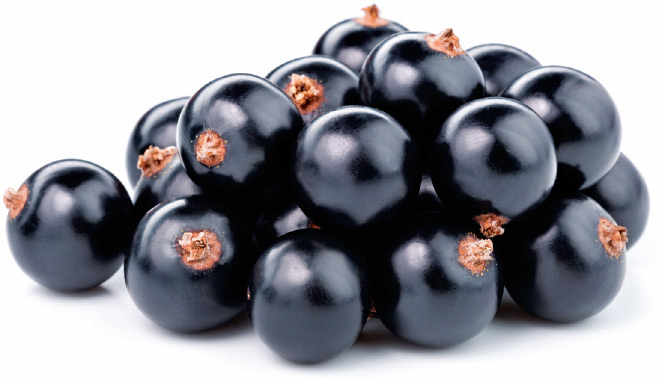
Black currant (also known as blackcurrant) is a shrub that produces pretty clusters of purplish berries during the summer. The berries are very tart, and they are usually combined with other fruits, or made into jams and jellies. They’re rare in the United States.
Various medicines are made from the leaves and fruits of the plant, and especially from the oil from the seed, which contains gamma-linolenic acid (GLA), the same active ingredient in evening primrose oil. It’s said to help ease inflammation. GLA was found to lower blood pressure and improve antioxidant status in an animal model, especially when combined in the diet with the two omega-3s found in fish oil—EPA and DHA.
In a published review of the health benefits of black currants, researchers noted “the potent anti-inflammatory, antioxidant, and antimicrobial effects of black currant constituents on a myriad of disease states.” Several studies have focused on the therapeutic potential of black currants regarding hypertension and other cardiovascular-associated illnesses, neurodegenerative diseases, and diabetic neuropathy.
 Blueberries
Blueberries

Mention blueberries around scientists, and you’re sure to hear the name of James Joseph, Ph.D.
Joseph was lead scientist in the Laboratory of Neuroscience at the USDA Human Nutrition Research Center on Aging at Tufts University. His special interest was what we should eat if we want to keep our marbles intact as we grow older. And it’s largely because of Joseph that blueberries now have a firmly established reputation as a memory-protecting food.
Blueberries Are Brain Food
In Joseph’s lab, he had something he called the Rat Olympics. He tested motor function and memory function with mazes and assorted tests for muscle strength and coordination. Around middle age, rats start showing the same kinds of decline in performance that humans do. But what Joseph’s studies show is that when you feed the lab animals extracts of blueberries, wonderful things start happening; or, more accurately, bad things don’t happen.
Bad things meaning mental deterioration. And loss of coordination and balance. Gone. Those rats that chowed down on the blueberries behaved like young studs. In Joseph’s lab, they’d found the Rat Fountain of Youth.
Blueberries contain compounds such as anthocyanin, which are antioxidant and anti-inflammatory. Inflammation and oxidative stress are involved in virtually every major killer disease: Alzheimer’s, Parkinson’s, diabetes, and heart disease, not to mention common conditions of aging such as arthritis. These compounds by themselves would be enough to land blueberries on anyone’s list of superfoods. Blueberries do even more. They help neurons in the brain communicate with one another more effectively.
BLUEBERRIES KEEP YOUR MEMORY SHARP
“Old neurons are kind of like old married couples,” said Joseph, who has since passed away. “They don’t talk to each other so much anymore.” Memory goes down, and the processing necessary for coordination and balance tend to decline. The technical term for this communication is signaling, and special compounds in blueberries called polyphenols turn on the signals. “Not only can you get one neuron to talk to another more efficiently, but you can enable the brain to grow new neurons,” Joseph explained in an interview.
Blueberries are the ultimate memory food. Animal studies have demonstrated that daily consumption of blueberries dramatically slows impairments in motor coordination and memory that are the usual accompaniments of aging. What’s more, they may help lower blood cholesterol and promote urinary health.
Bilberries, a close European cousin of the blueberry, have been shown to promote eye health and protect against glaucoma and cataract progression. In fact, wild blueberries are called “the vision fruit” in Japan, because they have very high concentrations of anthocyanins, natural antioxidants, and anti-inflammatories whose benefits include reducing eyestrain and improving night vision. And there are currently plans to study the ability of blueberries to prevent macular degeneration, a disease of the retina and the leading cause of blindness in people older than sixty-five.
Blueberries Are the Highest-Scoring Fruit of All Time
Then there are all those antioxidants and anti-inflammatory compounds, which help fight against cardiovascular disease. Back when the government was using a test known as the ORAC test (oxygen radical absorbance capacity) to measure antioxidant power in foods, blueberries were tested to have one of the highest ORAC values of any food in the world. The database of ORAC values was removed from the USDA Nutrient Data Laboratory website in 2012 due largely to the fact that food and dietary supplement companies were routinely misusing and misrepresenting ORAC scores to promote their products. Nonetheless, it’s worth noting that the ORAC test showed blueberries to be the highest-scoring fruit of all time.
Blueberries are a great source of compound called pterostilbene. On a cellular level, it works much like resveratrol in regulating fatty acid metabolism and fats in the bloodstream—and it helps prevent the deposition of plaque in the arteries.
Need more reasons to eat blueberries? How about fighting cancer? A University of Illinois study tested different fruits for the presence of a flavonoid that inhibits a cancer-promoting enzyme. Of all the fruits tested, wild blueberries showed the greatest anticancer activity.
Fresh or Frozen, You Choose
Best of all, you can get all these amazing health benefits by just adding 1/2 cup (75 g) a day of wild or frozen blueberries to your diet. No studies have been done to date comparing fresh to frozen to canned berries, but virtually all forms of the fruit have essential anthocyanins and proanthocyanins, making them a genuine health bargain. In fact, all of Joseph’s studies were done using frozen berries, which last time I looked, were relatively inexpensive and available in any grocery store freezer.
Throw them on a salad, in a blender with a protein powder, or best of all—my personal favorite—eat them frozen with a dollop of yogurt. The yogurt semi-freezes upon contacting the ice-cold blueberries, making the resulting blend the most delicious, healthy dessert you can imagine.
Cranberries
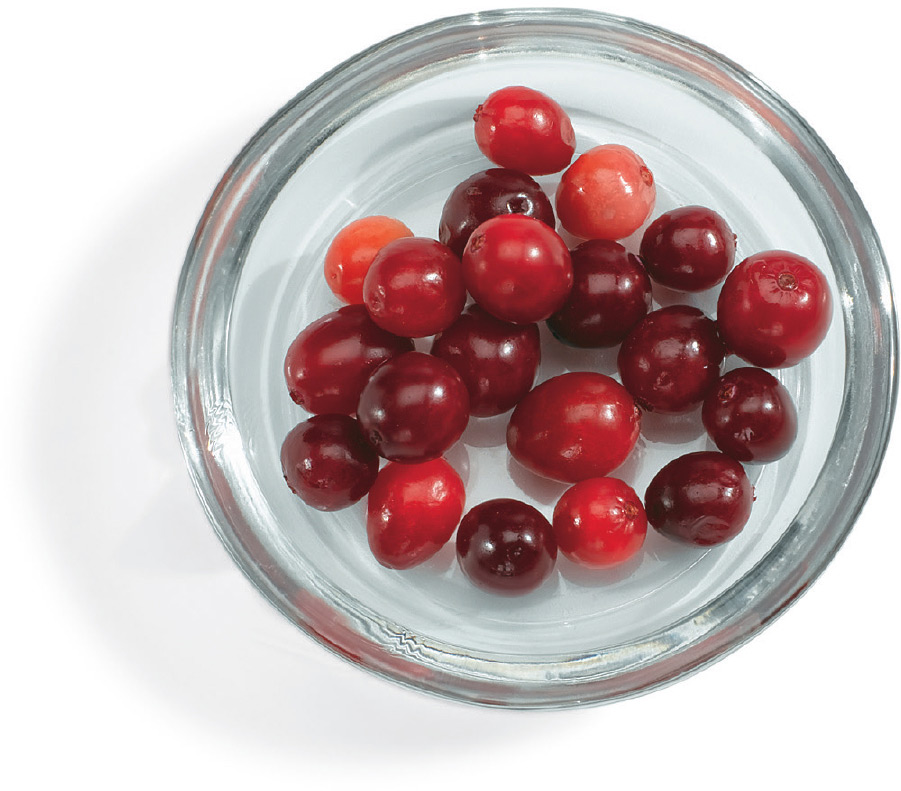
The only time most people come face to face with an actual cranberry is during Thanksgiving dinner, but there are a lot of reasons to get more familiar with this tart little red berry.
Cranberries are low in calories (44 per cup [110 g]), high in fiber, and low in sugar. But, like grapes, many of their real benefits aren’t clear from the typical nutrition facts label.
Cranberries Really Do Prevent UTIs
Studies presented at the twenty-third national meeting of the American Chemical Society show that the ruby red berries have some of the most potent antioxidants of any common fruits studied. They possess anticancer properties, inhibit the growth of common foodborne pathogens, and contain antibacterial properties to aid in the prevention of urinary tract infections (UTIs).
Catherine Neto, Ph.D., assistant professor at the University of Massachusetts–Dartmouth, isolated several bioactive compounds from whole cranberries and found compounds in the berries that were toxic to a variety of cancer tumor cells. “The tumor cell lines that these compounds inhibited most in our assays included lung, cervical, prostate, breast, and leukemia,” according to Neto.
Cranberries are high in phenols (also known as phenolic acids), plant chemicals known to be highly protective against a wide range of health problems and conditions. According to the Journal of Agricultural and Food Chemistry, cranberries had a higher phenol concentration than any of the twenty commonly eaten fruits studied: A 1/2 cup (55 g) contains 373 phenols per serving, more than red grapes, apples, strawberries, or blueberries.
What You Don’t Know about Cranberries
It’s widely known that cranberries help prevent UTIs. This is accomplished by preventing bacteria from sticking to the lining of the urinary tract (see also cranberry juice). More recently it has been discovered that the same properties help reduce bacterial adhesion to teeth, thus reducing the formation of dental plaque. Studies have also revealed that compounds in cranberries stop certain disease-causing bacteria from sticking to the stomach lining, thus helping to prevent ulcers.
Remember now, we’re talking about actual, raw cranberries here. Once you dry and sweeten them they may still have a lot of the healthful phenolic compounds, but the calories jump into the stratosphere (from 44 per cup [110 g] to 370 per cup!) and so does the sugar. If that’s not a problem for you—i.e., if you’re an avid hiker about to go out for five hours—by all means throw them in the trail mix! If not, use the dried and sweetened kind sparingly.
Note: You can get raw, whole berries in the frozen section of the grocers. I find them a terrific addition to smoothies. If the tart taste is too much for you, sweeten with some xylitol, erythritol, stevia, or—if you’re not too sensitive to the effects of sugar—a small amount of raw, unfiltered honey.
Elderberries
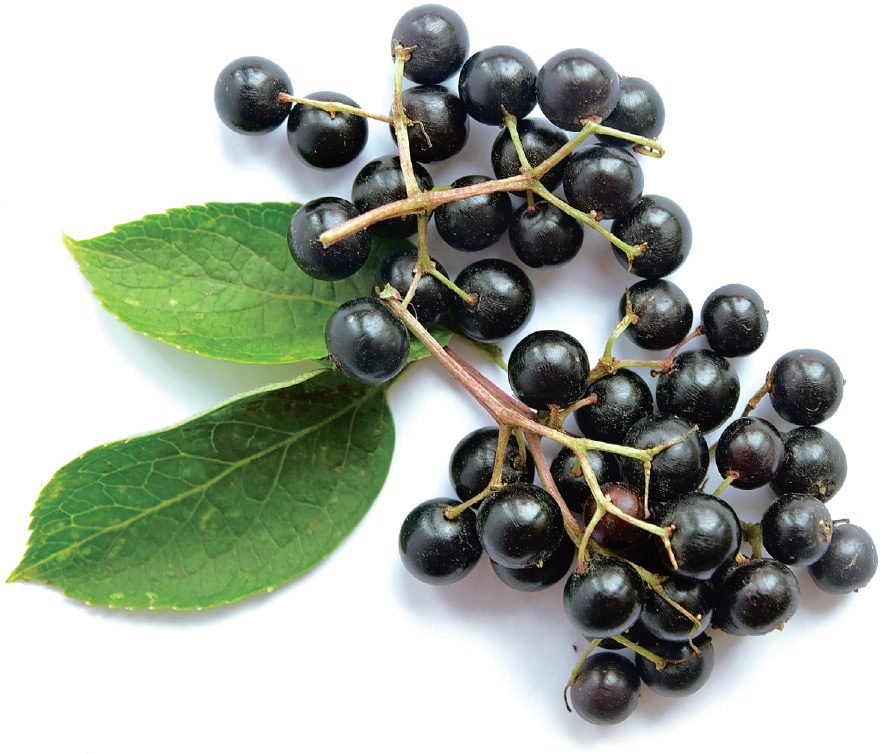
A couple of years ago, Mehmet Oz, M.D., posted an article called “The Brain Diet,” in which he and neurologist Majid Fotuhi, M.D., Ph.D., talked about the superfoods you must include in your diet to help prevent Alzheimer’s and boost your memory.
Ready for “Brain Superfood Number One”?
Elderberries.
These berries are nutritional and medicinal powerhouses.
So why aren’t we all eating them?
Two reasons. One, they’re impossible to find, and two, they taste horrible.
And you probably don’t want to go picking them wild, even if you could find them (which you probably can’t). Only the completely ripe, purple-blue (almost black) berries and flowers are edible. The unripe berries and seeds of the elder tree are poisonous. They contain glycosides—molecules consisting of a sugar and a non-sugar group—which release cyanide. Yup, that cyanide. Probably something you don’t want to be consuming.
Fortunately, you can get the medicinal properties of elderberry in a tasty extract form known as Sambucol. It’s available everywhere and it’s terrific.
Sambucol came into being because of research by a world-renowned Israel virologist, Madeleine Mumcuoglu. Back in the 1980s, Mumcuoglu began studying the elderberry, which had been used in medicine for centuries. Elderberry wine, for example, was traditionally used both for influenza and the chills. Mumcuoglu discovered the key active ingredient in elderberry and found it to be effective against the flu virus. She first tested it during the southern Israeli flu epidemic of 1992–1993 and found that within twenty-four hours, 20 percent of patients taking it had dramatic improvements in fever, aches, pains, and coughing. By the second day, a whopping 74 percent improved, and by the third day, 90 percent. In the untreated placebo control group, only 16 percent felt better after two days, and most took nearly a week to report feeling better. Mumcuoglu created a company—Razei Bar—which now markets the product.
Sambucol has been widely studied. Its main claim to fame is that it shortens the length of time you’re sidelined from the flu. In one study (Zakay-Rones, 2004), Sambucol relieved flu symptoms on an average of four days earlier. The researchers reported that “Elderberry extract seems to offer an efficient, safe, and cost-effective treatment for influenza.”
In another study, Sambucol was shown to be effective against ten strains of influenza virus, and reduced the duration of flu symptoms to three to four days. That’s impressive. If you’ve ever had the flu, you know you can easily be down for a week, and reducing that time by half would be awfully nice. The same study tested the effect of Sambucol products on a healthy immune system, specifically on the production of inflammatory cytokines, one of the immune system’s best weapons. Production of inflammatory cytokines, including TNF-alpha, were significantly increased. “We conclude from this study that, in addition to its antiviral properties, Sambucol Elderberry Extract and its formulations activate the healthy immune system by increasing inflammatory cytokine production,” wrote the authors. “Sambucol might therefore be beneficial to the immune system activation and in the inflammatory process in healthy individuals or in patients with various diseases.”
I keep Sambucol in the house and use it at the first sign of cold or flu. It’s the best way I know to get the medicinal properties of elderberries without having to traipse around North America or Europe in hopes of finding them in the wild. Plus you never have to worry about being poisoned!
Goji Berries
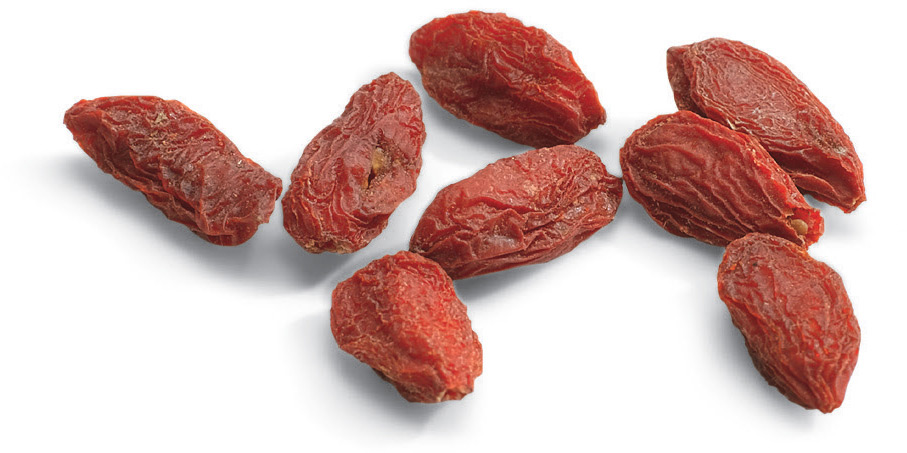
First things first. Goji berries are delicious. They’re also expensive. But partisans claim they are one of the best foods on the planet. A deep-red, dried fruit about the size as a raisin with an unusual taste—sort of a cross between a cranberry and a cherry—goji berries have been used in Tibet for at least 1,700 years. They’re used in Chinese medicine, and they’re traditionally regarded by the people of Tibet and elsewhere as a longevity, strength-building, and sexual potency food of the highest order.
Do Goji Berries Really Cure Cancer?
These exotic berries and the juices made from them (goji, noni, acai) are incredibly healthy foods. The problem is foods that have been used in medical and healing traditions for thousands of years generally don’t keep their reputation unless they actually deliver the goods.
Multilevel marketers discover these foods, and then you have a war in which everyone claims their product is the only “real” one. Fantastic health claims are made that range all over the map and compete for sheer silliness, and before you know it you’re in marketing hell and don’t know what to believe. I’ve seen websites that claim that goji berries cure cancer, guarantee you an extra twenty years of life, and make you a sexual superman. All of this is nonsense.
The goji berry is one of about eighty varieties of the Lycium berry (Lycium barbarum) that is indigenous to the Tibetan and Mongolian regions. A lot of published research exists on the Lycium berry, most of it positive, but none of it strong enough to support the claim that it cures cancer.
Marketing hype aside, this is a great food. Research shows that polysaccharides extracted from Lycium barbarum had a positive effect on insulin resistance in rats and a neuroprotective effect on animal cells. Polysaccharides extracted from the Lycium berry also demonstrate strong antioxidant properties. At least two studies showed they have a significant effect on the immune system. In one study, they reduced the weight of tumors; in at least two others, they protected animal cells from DNA damage.
When this book was first published in 2007, the goji berry wasn’t listed in the USDA database. Ten years later, data is available and it shows that those early champions of the goji berry had good intuition! A quarter cup (26 g) of goji berries has 90 calories, 4 g of protein, and 4 g of dietary fiber. It also has a little bit of vitamins A and C and iron—and, very likely, many unidentified flavonoids or phytochemicals with (likely) antioxidant and anti-inflammatory properties.
I say likely because it’s turned out to be the case with just about every other richly colored berry on the planet. So it’s a good guess it’s true for the goji as well. Stay tuned another ten years, and I hope I’ll be telling you I was right.
You can buy the juice if you don’t mind paying astronomical rates and wading through a bunch of multilevel marketing hype. Personally, I buy the organic berries themselves in a package at the natural food supermarket. One of my favorite raw-food breakfasts is made of raw oats, almond slices, apple slices, flaked coconut, and goji berries. Moisten with some pomegranate juice and enjoy!
Golden berries
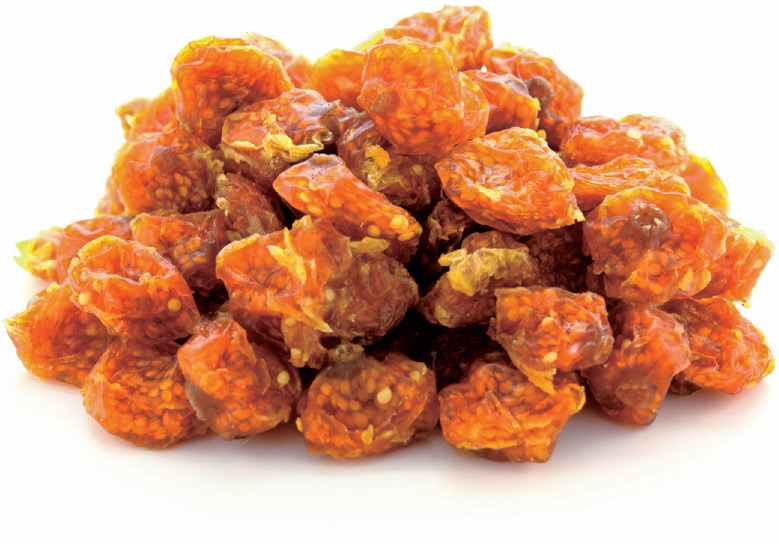
Golden berries look very much like golden raisins, but the resemblance is only superficial. Golden raisins, also known as sultanas, are simply golden-colored dried grapes. Golden berries—sometimes known as Cape gooseberry—are more closely related to eggplants and tomatoes than they are to berries. They’ve been described as a combination of sweet and tart, as tasting a bit like a sweet tomato. Some folks think they’re similar in taste to kumquats. And they’re roughly the size of a marble—about 1/2 to 3/4 inch (1 to 2 cm) in diameter.
Scientifically known as Physalis peruviana, golden berries (goldenberries) are loaded with important plant compounds, one of which is the important flavonoid quercetin. Quercetin is one of the most powerful natural anti-inflammatories I know of. I consider it so important that I often recommend quercetin supplements as part of an anti-inflammatory regimen.
One 2013 study investigated the main compound derived from golden berries, a chemical with the totally weird and unpronounceable name of 4β-Hydroxywithanolide E. The researchers wanted to investigate its “antiproliferative effect on a human lung cancer cell line.” They concluded that this natural compound found in golden berry was a potential chemotherapeutic agent against lung cancer.
Goldenberries have high levels of vitamin C, vitamin A and the vitamin B-complex (ibid). They’re also one of the few food sources for a unique group of organic compounds called withanolides. Withanolides are both antioxidant and anti-inflammatory. (Withanolides are also found in the adaptogenic healing plant ashwaganda.) Not surprisingly, studies have demonstrated that golden berries do indeed have both anti-inflammatory and antioxidant properties.
Many health or natural food stores carry goldenberries in bulk or by the bag. You can also order them online.
Gooseberries and Amla
(Indian Gooseberries)
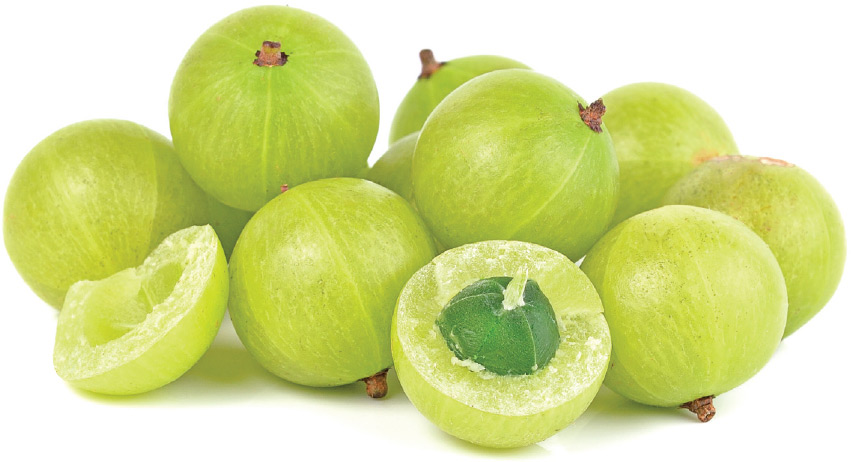
Gooseberries are closely related to currants—you might even call them the currant’s “kissing cousin.” They’re small berries. They’re usually oval shaped (but not always), and they come in all different colors and flavors. They grow wild in Europe, North America, and Siberia, thriving best in places where summers are humid but winter is harsh and chilly. And they’re loaded with antioxidant polyphenolics and various vitamins.
Gooseberries contain small amounts of essential vitamins such as pyridoxine (vitamin B6), pantothenic acid (vitamin B5), folate, thiamin (vitamin B1), and vitamin A. Gooseberries also contain decent levels of minerals such as copper, calcium, phosphorus, manganese, magnesium, and potassium.
Many parts of the gooseberry plant are used to treat various diseases, but the most important part is the fruit—the actual berry. It’s used either alone or in combination with other plants to treat many ailments such as the common cold and fever; as a diuretic, laxative, liver restoration; treatment of stomach issues; anti-pyretic; anti-inflammatory; hair tonic; to prevent peptic ulcer and dyspepsia, and as a digestive aid.
Indian gooseberries, also known as amla, are quite different from gooseberries even though they share a name. A study published in the European Journal of Cancer Prevention in 2011 referred to amla as “a wonder berry in the treatment and prevention of cancer” (Baliga, 2011). The researchers called amla (Indian gooseberry) “arguably the most important medicinal plant in the Indian traditional system of medicine, the Ayurveda.” Some of its constituents—like ellagic acid—have long been studied for their anticancer activity, and studies show that amla possess neuroprotective, liver-protective, kidney-protective, gastroprotective, and cardioprotective properties.
Amla berries are extremely high in antioxidants and vitamin C—but they are also very acidic and bitter tasting. They do have significantly high amounts of phenolic phytochemicals, especially flavones and anthocyanins. Many of these compounds have been found to have anticancer, anti-inflammatory, and antiaging benefits, and they also seem to offer some measure of protection against neurological diseases. Amla also contains other antioxidant compounds like tannins (emblicanin, punigluconin and pedunculagin) as well as the vitamin C (445 mg for about 4 ounces [115 g] of amla!)
Mulberries

Mulberries look like the offspring of a blackberry and a raspberry. They’ve been used in Chinese herbal medicine for thousands of years, primarily to treat heart disease, diabetes, anemia, and arthritis. They have a high total phenolic content—i.e., they’re loaded with plant compounds such as anthocyanins and chlorogenic acids, which have multiple health benefits (Isabelle, 2008).
There are twenty-four species of mulberry trees. Most commonly grown are black, white, and red. The black ones appear to have more antioxidant power (Ercisli, 2007). They’re low in calories (60 per cup [140 g]), and are often consumed dried (such as raisins). They’re an excellent source of vitamin C and iron, and a good source of vitamin K1, potassium, and vitamin E.
They’re also rich in plant compounds called anthocyanins, which are responsible for their color and have a number of proven health benefits. For one thing, anthocyanins inhibit the oxidation of LDL cholesterol. When cholesterol is oxidized (damaged), that’s the time we need to worry about it, so anything that slows down that damage is a good thing indeed.
Mulberries contain an interesting compound called DNJ (1-deoxynojirimycin), which inhibits an enzyme that breaks down carbs, and is therefore considered to be beneficial against diabetes because it slows down the rise in blood sugar that happens after meals.
Polyphenols—such as those in mulberries—have great potential for cardiovascular disease. They also reduce oxidative stress, which is a component of many diseases, including (but not limited to) cancer.
Mulberries are sweet and delicious and packed with nutrition. They have quite a range of potential benefits.
 Raspberries
Raspberries
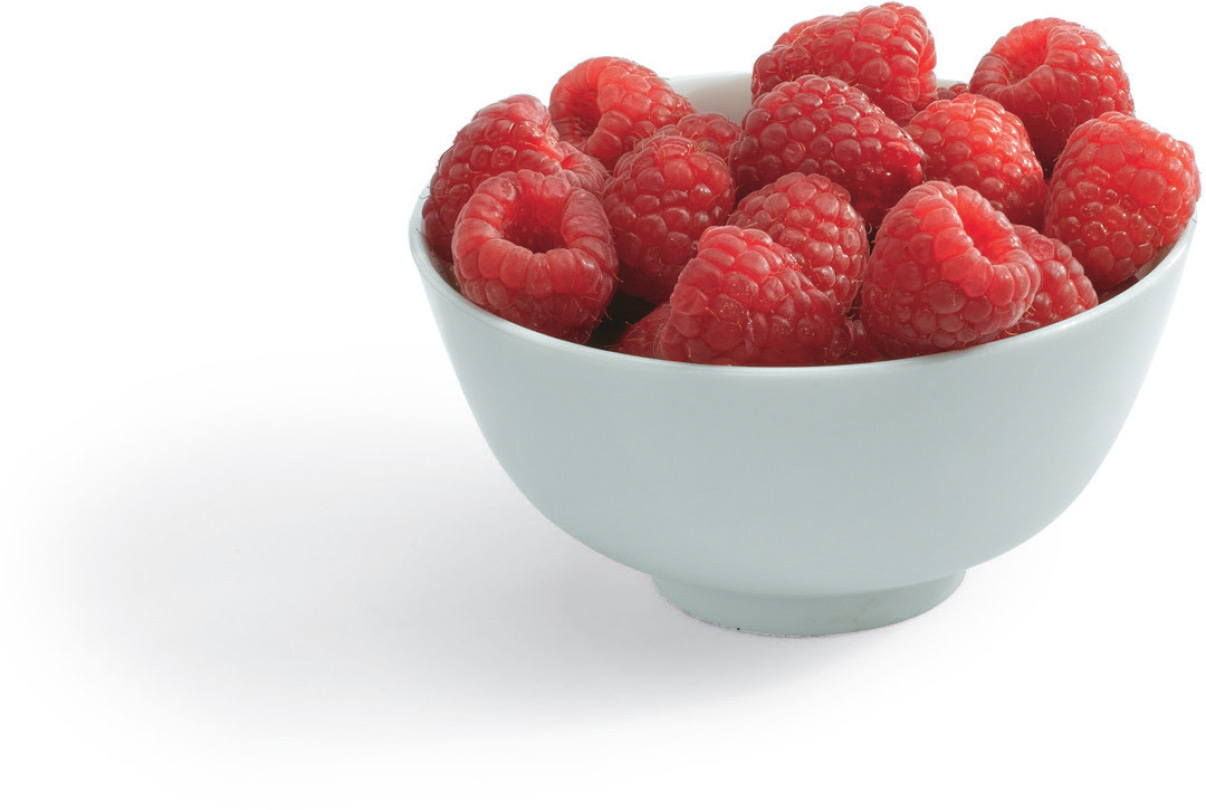
Raspberries deserve a place of honor on the healthy foods list if for no other reason than the fact that they are a high-fiber powerhouse. For a measly 64 calories a cup (125 g), they provide—get this—8 g of dietary fiber, making them calorie for calorie one of the most high-fiber foods on the planet.
But the benefits of raspberries hardly stop with the fiber. Raspberries have calcium, magnesium, phosphorus, potassium, vitamin C, and bone-building vitamin K. And, if you’re watching your carbs, only about 7 g of “net” carbs (the kind that count) per cup. But that’s just what shows up on the nutrition facts label. There’s way more to this picture than meets the eye.
Raspberries’ Ellagic Acid Fights Cancer Cells with No Damage to Healthy Cells
Raspberries are one of the best sources on the planet of ellagic acid. Ellagic acid, also found in cherries and strawberries, has been shown in animal research and in laboratory models to inhibit the growth of tumors caused by certain carcinogens. A publication by the American Cancer Society called The American Cancer Society’s Guide to Complementary and Alternative Cancer Methods says that ellagic acid is a promising natural supplement because it causes apoptosis (cell death) of cancer cells in the lab, with no change to healthy, normal cells.
Here’s how it works: Healthy cells have a normal life cycle of approximately 120 days before they die. This process is called apoptosis (natural cell death). The body replaces the dying cells with healthy cells, and life goes on. But with cancer cells, no such luck. Instead of dying, they multiply by division, making two, then four, then eight cancer cells (and so on). In lab tests, ellagic acid caused the cancer cells to go through the normal apoptosis process without doing damage to healthy cells. (Remember, chemotherapy and radiation cause the death of cancer cells also, but they leave some powerful side effects.)
No one is saying that ellagic acid cures cancer—but it’s interesting and promising that it has shown such beneficial activity in the lab. Perhaps it will turn out to benefit humans as well. According to studies posted on the Memorial Sloan Kettering Cancer Center website, ellagic acid also has antiviral and antibacterial properties.
Raspberries Could Be a Natural Arthritis Treatment
Raspberries also contain anthocyanins. Anthocyanins have the ability to inhibit cyclooxygenase, a compound produced in the body in two or more forms, called COX-1 and COX-2. COX-2 is built only in special cells and is used for signaling pain and inflammation. (It was the ability of arthritis drugs like Vioxx and Celebrex to inhibit COX-2 that made them effective.)
Unfortunately, at least in the case of Vioxx, side effects were dangerous enough to cause it to be withdrawn from the market. Anthocyanins, on the other hand, have no such side effects. Research conducted at Michigan State University investigated a range of fruits and berries for the level and activity of anthocyanins found in each. The yield of pure anthocyanins in raspberries was the second highest of all the fruits tested. (Cherries were first, but not by much.) And anthocyanins also have significant antioxidant activity as well.
Raspberries are fragile. They’ll turn to pulp if you hold them in your hand too long. So if you buy them fresh, handle carefully, and eat soon. You can also get them frozen, and they’re great in shakes.
 Strawberries
Strawberries
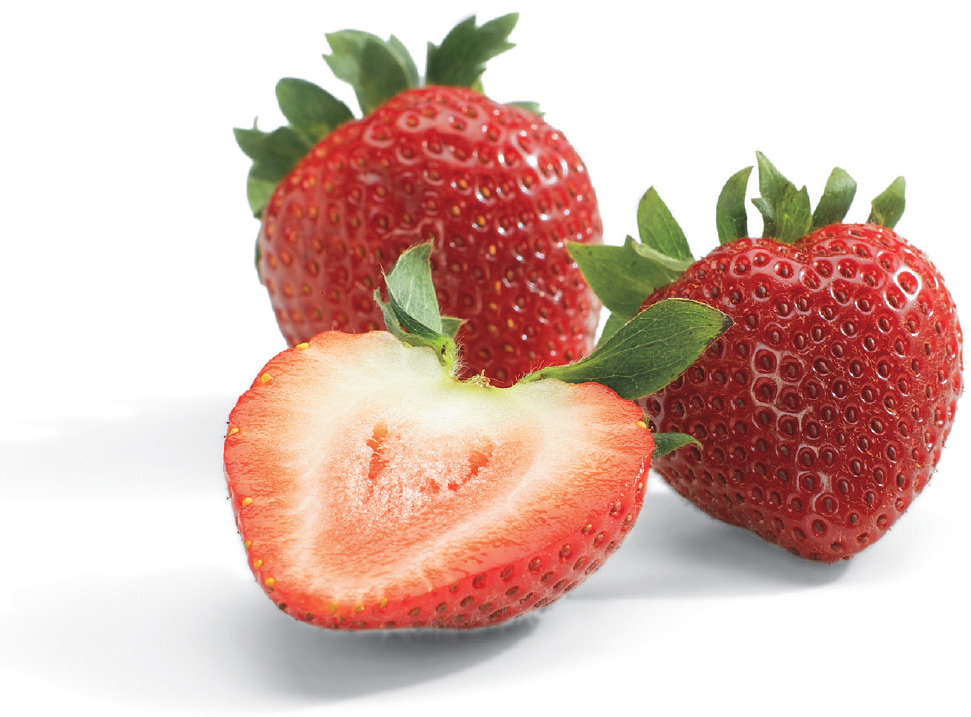
Strawberries, like all berries, are a real health bonanza. All berries—strawberries, blueberries, raspberries—contain chemicals found to protect cells against cervical and breast cancer. Researchers at Clemson University tested freeze-dried fruit extracts against two cultures of aggressive cervical cancer lines and two breast cancer cell lines. Extracts from strawberry and blueberry significantly decreased the growth of cervical and breast cancer cells.
In fact, preliminary data reported on the USDA website suggest that phytochemicals from strawberries and blueberries inhibit steps in tumor initiation. In addition, a study published in the Journal of Agriculture and Food Chemistry analyzed eight types of strawberries for their content of protective plant compounds like phenols and anthocyanins, as well as for their antioxidant capacity. All eight types of strawberries were able to significantly inhibit the proliferation of human liver cancer cells. And a number of other analyses have shown that strawberries have potent antioxidant action.
Strawberries also contain ellagic acid, which you may have read about in my discussion on cherries and raspberries. Research since 1968 has shown that ellagic acid has anticarcinogenic and antimutagenic activity. Ellagic acid is a naturally occurring phenolic compound in many plants, especially strawberries, raspberries, and blackberries. Ellagic acid has been shown in animal research and in laboratory models to inhibit the growth of tumors caused by certain carcinogens. The American Cancer Society’s Guide to Complementary and Alternative Cancer Methods says that ellagic acid is a very promising natural supplement because it causes apoptosis (cell death) of cancer cells in the lab, with no change to healthy, normal cells.
Strawberry Compound May Improve Short-Term Memory
Compounds in strawberries may also protect your brain and memory. Researchers at Tufts University and the USDA published a study in the Journal of Neuroscience showing that animals that consumed an extract of blueberries, strawberries, and spinach every day had significant improvements in short-term memory. The rats that received the fruit and vegetable extracts learned faster than the other rats, and their motor skills improved significantly. This study was the first to show that fruits and vegetables actually reverse dysfunctions in behavior and nerve cells. The extracts also protected their little blood vessels against damage.
Strawberries also contain anthocyanins. Anthocyanins have the ability to inhibit cyclooxygenase, a compound produced in the body in two or more forms, called COX-1 and COX-2. COX-2 is built only in special cells and it is used for signaling pain and inflammation. It’s COX-2 that we want to turn the volume down on if we want to inhibit pain. That’s what arthritis drugs like Vioxx and Celebrex did—they inhibited COX-2, and that made them effective. Unfortunately, at least in the case of Vioxx, side effects were dangerous enough to cause it to be withdrawn from the market.
Anthocyanins, on the other hand, turn down the volume on COX-2 but have no nasty side effects. Though the anthocyanin content in strawberries isn’t as high as that in cherries or raspberries, it’s still significant. And anthocyanins have significant antioxidant activity as well.
A cup (170 g) of strawberries has only about 50 calories and delivers about 3 g of fiber. It has calcium, magnesium, phosphorus, and potassium, plus a very nice dose of vitamin C (about 85 mg).
Cantaloupe

All melons are high-volume foods. That means that for a given amount of weight, they contain a relatively high amount of water, fiber, and air—and a relatively low number of calories. Why should it matter? Consider this.
The Benefit of High-Volume Foods
Barbara Rolls, Ph.D., a nutrition researcher at Pennsylvania State University, has done a ton of research on appetite and appetite control. She has found that people ate about 3 pounds (1.4 kg) of food daily, regardless of whether the food was high calorie or low calorie. After about 3 pounds, people stopped eating. They’d eat nearly identical servings of food (by weight), whether it was watermelon (high volume) or cheesecake (low volume). Most important, the subjects in her studies felt just as full after the low-calorie meals as they did after the calorie-rich meals—as long as both meals contained the same volume of food.
Cantaloupe is a high-volume food. An entire large melon has only 277 calories, much less than most desserts, and more than most people can eat at one sitting. A typical serving is a wedge, or maybe half a melon. About 90 percent of the melon is water. As Rolls has shown in her research, study after research study, the water in the melon goes a long way toward filling you up. By the way, water in foods seems to do this more than water that you drink alongside foods. Melons and soups do a better job of appetite control than solid food plus a glass of water.
Cantaloupe Lowers the Risk of High Blood Pressure and Stroke
Cantaloupe’s not a great food just because it’s high-volume and low-calorie. It’s also rich in potassium and vitamin A. One cup (156 g) of melon cubes provides 427 mg of potassium and a little calcium and magnesium). Many studies show that people who eat potassium-rich foods have lower rates of heart disease and stroke. Potassium is also a key component of healthy blood pressure.
According to the latest studies, people who regularly consume high-potassium foods have lower blood pressure than those who don’t. A review of thirty-three studies examined the effect of potassium on blood pressure, and researchers discovered that participants who added 2,340 mg of potassium daily (from foods, supplements, or both) lowered their risk of developing high blood pressure by 25 percent. The reductions were ultimately greatest for people who already had high blood pressure. Another possible benefit of potassium: It may protect against stroke. People with high blood pressure who had a daily serving of potassium-rich foods (such as figs) decreased their risk of fatal stroke by 40 percent, according to one study.
Then there’s vitamin A and beta-carotene, both of which are plentiful in cantaloupe. Though a lot of people know about vitamin A’s role in vision and growth and bone development, what’s not as well known is how terrific it is for the immune system. I consider it one of the best immune system boosters around.
Eat Cantaloupe to Ward Off a Cold
Vitamin A deficiency results in decreased resistance to infection. But you don’t really have to have a deficiency to benefit from its effect on the immune system. There is some evidence that vitamin A can stimulate and otherwise favorably affect the immune system even in the absence of vitamin A deficiency. Whenever I feel a cold coming on, I take large doses of supplemental vitamin A for a few days, plus a few other things such as C, zinc, and N-acetyl-cysteine. It works. And some years ago, it was demonstrated that high-dose vitamin A can significantly protect against some of the immune-depressing effects of radiation and cancer chemotherapy.
Beta-carotene, a carotenoid that turns into vitamin A in the body, has protective health properties of its own. A cup (156 g) of cantaloupe cubes has more than 3,000 mcg of beta-carotene. Beta-carotene, in addition to being a great antioxidant that protects against cellular damage, may be protective against some forms of cancer in some populations; it may also play a role in protecting against heart disease. Though a large study a few years ago that looked at the effect on smokers of large supplemental dosages of synthetic beta-carotene had disappointing results, there is overwhelming epidemiologic evidence that those who consume three or more servings of fruits and vegetables daily have significantly lower risk of many forms of cancer and heart disease and that the protective association is particularly strong for dietary carotenoids, especially with respect to protection against lung cancer.
Cantaloupe also makes a great juice, and if your juicer can handle it, you don’t need to remove the skin. You can mix cantaloupe and watermelon juices with sparkling water for an amazing summer cooler, or vary the recipe and add lemon juice and ginger.
 Cherries
Cherries

“The day when doctors say ‘take 10 cherries and call me in the morning’ may not be far off,” said a Newsweek article. You might wonder what the writer was talking about if you looked cherries up in a food database. What’s the big deal? Sure, they’re relatively low in calories, and, like most fruits and vegetables they’re a good source of potassium. And the sour ones have a nice amount of vitamin A. But the real benefits of cherries are not in plain sight, at least not if the only place you look is on the nutrition facts label. And when you understand the real benefits, suddenly the Newsweek reporter’s comment starts to make a lot of sense.
Why? Because cherries are loaded with anti-inflammatory, antiaging, anticancer compounds that don’t show up on your average nutrition facts label. The cancer-fighting agents in cherries include a flavonoid called quercetin, as well as ellagic acid and perillyl alcohol.
The Wonders of Quercetin and Ellagic Acid
Quercetin has been found by researchers to be a potent anticancer agent. It also exhibits significant anti-inflammatory activity, which is why quercetin is one of my favorite supplements for allergies and asthma. Ellagic acid is a naturally occurring phenolic known to be both anticarcinogenic and antimutagenic.
Also found in red raspberries, ellagic acid has been shown in animal research and in laboratory models to inhibit the growth of tumors caused by certain carcinogens. The American Cancer Society’s Guide to Complementary and Alternative Cancer Methods says that ellagic acid is a very promising natural supplement because it causes apoptosis (cell death) of cancer cells in the lab, with no change to healthy, normal cells. According to studies posted on the Memorial Sloan Kettering Cancer Center website, ellagic acid also has antiviral and antibacterial properties.
Perillyl Alcohol in Cherries May Inhibit Tumor Growth
Another compound in cherries is perillyl alcohol. Though the exact mechanism of its action is unknown, it appears that perillyl alcohol and its metabolites may inhibit tumor growth. In animal models, it exhibited this effect in pancreatic, stomach, colon, skin, and liver cancers. The Cleveland Clinic Taussig Cancer Center is currently running phase one of a multiple-dose trial of perillyl alcohol on healthy women with a history of breast cancer.
Cherries have been shown to lower levels of uric acid in the blood, which is one of the most common causes of gout pain. A study at the University of California–Davis showed that consuming a serving of cherries daily significantly lowered the blood uric acid levels of women by as much as 15 percent.
Even Cherry Juice Packs a Punch
The benefits of cherry juice are in compounds called anthocyanins, pigments that give cherries their bright red color and are believed to help the body relieve inflammation. These same anthocyanins may significantly reduce your risk for colon cancer, the third leading cancer in America.
Doctors and scientists believe that it’s the anthocyanins in the cherries that cause the decrease in blood urates and the relief from gout pain.
Anthocyanins act like natural COX-2 inhibitors. COX stands for cyclooxygenase, which is produced in the body in two or more forms, called COX-1 and COX-2. COX-2 is used for signaling pain and inflammation. The popularity of arthritis drugs such as Vioxx and Celebrex was based on their unique ability to block only the pain and inflammation messages of COX-2 while leaving the noninflammatory COX-1 alone. Unfortunately, there were some really unpleasant side effects associated with Vioxx, and it was taken off the market. But anthocyanins produce a similar effect with none of the problems of drugs.
Cherries (and raspberries) have the highest yields of pure anthocyanins. In one study, the COX inhibitory activity of anthocyanins from cherries was comparable to those of ibuprofen and naproxen. And researchers feel that in addition to helping with pain and inflammation, consuming anthocyanins on a regular basis may help lower heart attack and stroke risk.
Your New Favorite Dessert
You can get the health benefits of cherries by eating the tart ones whole, or by juicing them. I have a favorite secret dessert that I’ll share with you: I buy organic frozen red cherries and put them in my freezer. When I’m ready to eat them, I put them—direct from the freezer—into a little bowl with some raw milk or yogurt, which promptly semi-freezes on the cherries, forming a kind of ice milk. Stir it up, and the resulting mixture is like Cherry Garcia ice cream, only with a zillion times more health benefits. It’s delicious, and it’s my secret weapon against the dreaded Attack of the Ice Cream Craving (and I know you know what I’m talking about!).
 Coconut
Coconut
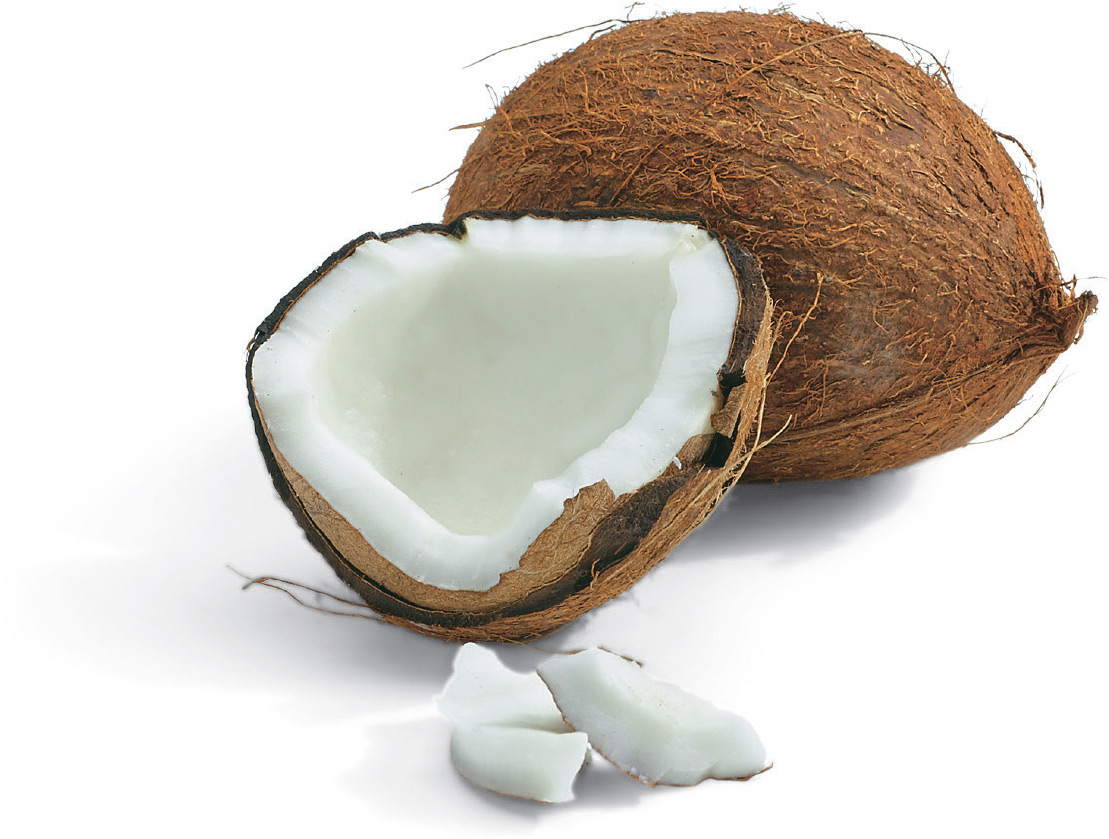
I really looked forward to writing this section, because I felt it would give me a chance to right one of the greatest nutritional misconceptions of all time: the idea that coconut is bad for you because it contains saturated fat.
Let me be very clear at the outset: Coconut and coconut oil are superfoods. Coconut—and its oil—is one of the most healthy, amazing things you can ingest.
Island Studies Prove the Value of Coconut
The good news on coconut started with research back in the 1960s and 1970s. It has long been observed that people from the Pacific Islands and Asia whose diets are very high in coconut oil are surprisingly free from cardiovascular disease, cancer, and other degenerative diseases. A long-term, multidisciplinary study was set up to examine the health of the people living in the small, idyllic coconut-eating islands of Tokelau and Pukapuka. And what it found was astonishing. Despite eating a high-fat diet (35 to 60 percent of their calories were from fat, mostly saturated fat from coconuts), the Pukapuka and Tokelau islanders were virtually free of atherosclerosis, heart disease, and colon cancer. Digestive problems were rare. The islanders were lean and healthy. There were no signs of kidney disease, and high blood cholesterol was unknown. Yet when these native people moved to the big cities, changed their diets, and gave up eating coconut oil in favor of the refined polyunsaturated vegetable oils that are believed to be healthier, their incidence of heart disease increased dramatically.
A 1/2 cup (47 g) of shredded coconut meat has almost 4 g of fiber, 142 mg of potassium, 13 mg of magnesium, less than 3 g of sugar, and—most important—13 g of the most heart-healthy, life-supporting fat on the planet (more on that in a moment).
Saturated Fat in Coconut Is Nothing to Fear
Since the original publication of this book, a lot has changed in the public perception of coconut and coconut oil. Before 2011, the year the Dr. Oz show debuted on television, Mehmet Oz, M.D., had a radio show on the Oprah Channel on SiriusXM. I appeared on that show for the full hour, and we discussed, among other things, coconut and coconut oil. Oz’s writing partner, the distinguished physician and chief wellness officer of the esteemed Cleveland Clinic, Michael Roizen, M.D., was on the show with us, and I called coconut oil a superfood. Roizen basically said I was crazy—that coconut oil was terrible for you, it was highly inflammatory, and it contained saturated fat. I have (and had) great respect for Roizen, but he was dead wrong about this. I was gratified to see that a couple of years later, Oz himself listed coconut oil on his website as one of his favorite superfoods. (Google “Dr. Oz’s Favorite Superfoods,” and you can see for yourself.)
Still, in the eyes of many consumers, coconut suffers from a completely undeserved negative reputation. And how did coconut come to get this bad reputation? You guessed it—because it has fat. Not only does it have fat, it has saturated fat. And because of the mass hysteria and widespread misinformation about saturated fat in this country, most people think anything that has saturated fat should be avoided like the plague. Back in 1962, one writer observed that “the average American now fears saturated fat the way he once feared witches.” I believe that’s still true today, despite quite a lot of research disproving the notion that saturated fat has anything to do with heart disease.
The point here is this: amazing health foods such as eggs (with their yolks) and coconut have been absent from the American diet for no other reason than that people—including doctors—simply don’t understand the full story when it comes to fat.
The human body needs fat. We can’t exist without it. It’s incorporated into our cell membranes. It’s used as an energy source. It cushions and protects our organs. It makes certain critical vitamins—such as vitamins A and D—available to us. Some fats—like sterols—serve as the basic molecule for important hormones like the sex hormones. And fats are the precursors for a whole group of important compounds in the body known as prostaglandins that are vitally important for human health. (For more on the right way to incorporate fat into your diet, see my book with Steven Masley, M.D., Smart Fat: Eat More Fat, Lose More Weight, Get Healthy Now.)
Coconut’s Medium-Chain Fatty Acids Are Easier to Metabolize
What we know as fats and oils are mostly made up of smaller compounds called fatty acids. These fatty acids—whether they’re saturated or unsaturated—come in many different lengths. For convenience’s sake, they’re classified into three groups: short, medium, and long.
The saturated fats in coconut are mainly medium chain—they’re also known as MCTs (medium-chain triglycerides). The physiology and biochemistry of medium-chain triglycerides are very different from their long-chain, saturated fat cousins. For one thing, they are easier to metabolize. For example, AIDS patients suffering from fat malabsorption and chronic diarrhea with weight loss were significantly benefited by a twelve-week regimen of medium-chain triglycerides. MCTs are also preferentially used for energy rather than stored as fat around your hips. Most important, they are mainly composed of a fat called lauric acid, which is antiviral and antimicrobial. According to no less a source than the Physicians’ Desk Reference, there is preliminary evidence that MCTs may be helpful in some cancers and may have some positive effects on immunity.
Fifty percent of the fat in coconut is lauric acid. In the human body, lauric acid is formed into monolaurin, which is basically a bug killer: it’s antiviral and antibacterial. The late Mary Enig, Ph.D., who was arguably one of the most distinguished lipid biochemists in the country, wrote eloquently on the antiviral and antibacterial effects of lauric acid and coconut in general, documenting its effects on a host of microbes and quoting study after study after study showing its immune-enhancing effects. She has also debunked the idea that the saturated fat in coconut has any adverse effects on the heart or on health in general. (Many of Enig’s essays for the public are available online; they’re tough reading, but rigorously documented with strong science.)
Coconuts May Protect against STDs
Another 6 or 7 percent of the fatty acids in coconut fat are MCT called capric acid. Capric acid is formed in the human body into monocaprin, which has been shown to have antiviral effects. It is being tested for effects against herpes and antibacterial effects against chlamydia and other sexually transmitted bacteria.
Though some people believe MCTs can be helpful for weight control and athletic performance (because they are an easily metabolized source of calories that are not likely to be stored as fat), this use is controversial. One researcher estimated that people would have to eat more than 50 percent of their calories as MCTs to lose weight, though others have suggested that the percentage is lower. What is not controversial at all is the use of MCTs therapeutically for cystic fibrosis, AIDS, cachexia (physical wasting secondary to cancer), and childhood epilepsy.
But you don’t have to have any of those diseases to benefit from some healthy MCTs in your diet, the best food source of which is coconut and coconut oil. Remember the Pukapuka and Tokelau islanders: they ate a ton of coconut and very little processed food, and they had hardly any heart disease. In today’s world, any food that tastes delicious and can enhance your immune system at the same time deserves a place in the honor roll of healthy foods.
Dates
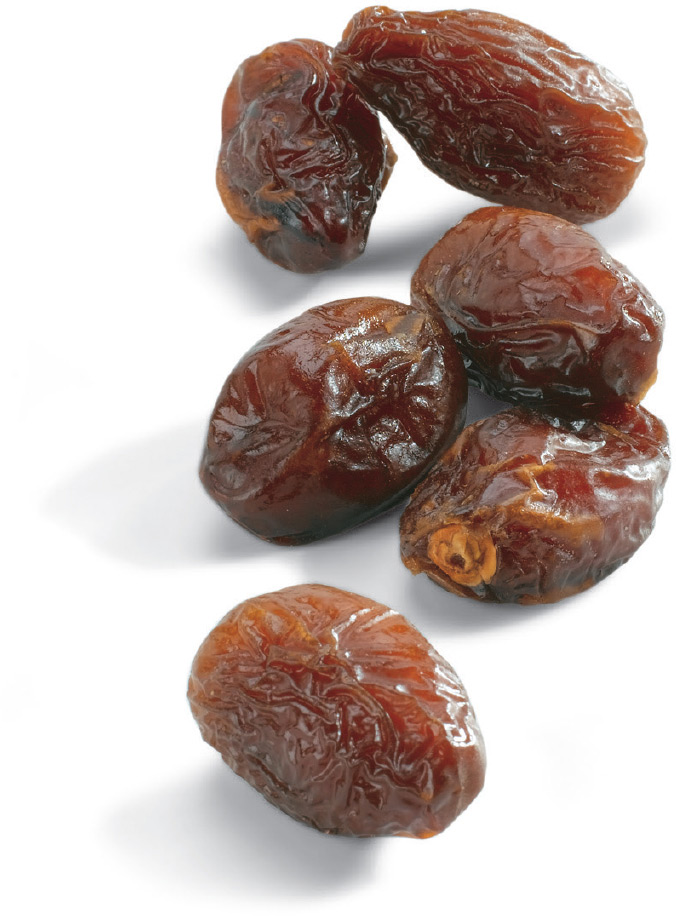
Dates are described as “nature’s candy”—anyone who’s ever tried them knows why. But dates aren’t on this list because they are such an amazing source of nutrients you can’t get anywhere else. No. They’re on this list because well, let’s face it, we love sweets, and if we’re going to eat sweets, they might as well come in a package that does minimal harm and actually might do some good. Enter dates.
Full of Sugar, and Full of Nutrients
Dates are not a low-calorie food, nor are they a low-sugar food. A single large pitted date has a whopping 66 calories, not bad if you eat just one, which, unfortunately, almost nobody does. But that same single date has calcium and magnesium in an almost perfect 1:1 ratio (15 mg to 14 mg), 11/2 g of fiber, and more than 160 mg of heart-healthy potassium. There’s even a smidgen of vitamin A, plus trace amounts of a half dozen other vitamins and minerals. You can’t say that about a lot of commercial candy bars! The royalty of dates is the Medjool, which most people regard as the best-tasting variety.
And wait, there’s more! In a comprehensive study published in the Journal of the American College of Nutrition, Harold Miller, Ph.D., and his colleagues analyzed the antioxidant content of cereals, fruits, and vegetables using a complicated scientific method that scores the foods in units called Trolox equivalents (TEs). The findings were surprising. Miller found that many popular vegetables tended to be relatively low in antioxidants. Of the fruits, his team found that red plums had the highest TE score (2200). Of the berries, blackberries won handily with 5500. And of the dried fruits, the winner was… dates! On the TE score, dates beat the nearest competitor (raisins) with a score of 6600!
Dates come in various states of dryness. The most common of the semidry dates is the Deglet Noor. Six Deglet Noor dates provide a reasonable 140 calories plus a very respectable 4 g of fiber, a bit of calcium, magnesium, and a nice 327 mg of potassium.
Who Should Avoid Eating Dates?
If you’ve got blood sugar issues, including metabolic syndrome or diabetes, or if you’re trying to lose weight and control sugar, you might want to pass on this one. But if you’re an athlete looking for a natural healthy food to provide sugar and calories or to help replace glycogen after a workout, dates might have a place in your kitchen. Chopped up and mixed with some higher-fat, lower-sugar foods like organic almonds and other nuts, they make the perfect trail mix for a long hike.
I rediscovered the joy of dates (and the joy of figs) when Michelle and I were vacationing in our beloved St. Martin, where—if enough of you buy this book and tell your friends—we may someday retire. (Just kidding about retiring.) We rented a house and made a lot of our own meals. There are tons of vendors along the roads selling delicious fresh fruits, and the markets have terrific cheeses, figs, and dates.
One of our go-to mini-meals was a plate of dates, figs, cheeses, and grapes, sometimes accompanied by apples. The dates are so sweet and delicious you can’t believe they aren’t candy, and the sweetness of the dates tempered with the flavor of tart or creamy cheeses and the juiciness of the grapes (or apples) is a food experience that’s hard to beat, especially when you’re eating it in a gorgeous tropical island.
Figs

I love figs. Fresh or dried, they’re luscious, chewy, rich, textured, and sweet as honey. And, like dates, they might not be the single most nutritionally dense food on the planet, but they sure beat candy if you want some instant sugar in a nice nutritional package.
I recently rediscovered figs, when Michelle and I went on vacation to St. Martin. We rented a house, and we wanted to have as many healthy snacks and light meals around as possible so as not to have to eat out too often. (Restaurants on the French side of St. Martin are very expensive.) We discovered packaged local dried figs in the supermarket, took them home, and paired them with Brie and macadamia nuts. And now that’s my new favorite snack!
Figs for Maximum Fiber
Besides tasting great and producing the famous leaves that covered key parts of Adam and Eve, figs have several claims to fame. First is fiber. The American Diabetes Association—with whom I rarely agree—is right on this one: When it comes to fiber, people should eat 25 g to 50 g a day. The National Academy of Sciences says 21 g to 38 g, depending on age and sex. Want to know what the average American takes in? A paltry 11 g. Research from Harvard University has shown that men with the highest dietary fiber intake (about 29 g a day) had a 40 percent reduction in heart attacks compared to men eating the least fiber. High-fiber diets are associated with better blood sugar control and with much better weight control. Six figs contain almost 5 g of fiber, making them a high-fiber food in my book.
Then there’s calcium. That same six figs (about 125 calories) give you 82 mg of calcium (plus 34 mg of magnesium). That’s more than three times the amount in a glass of orange juice.
You also get a whopping 473 mg of potassium, making figs a high-potassium food. A ton of studies show that people who eat potassium-rich foods have lower rates of heart disease and stroke. And potassium is a key ingredient in keeping blood pressure down. According to the latest studies, people who regularly consume high-potassium foods have lower blood pressure than those who don’t. In a review of thirty-three studies that examined the effect of potassium on blood pressure, researchers discovered that participants who started out with normal blood pressure and then added 2,340 mg of potassium daily (from foods, supplements, or both) could lower their risk of developing high blood pressure by 25 percent. The reductions were ultimately greatest for people who already had high blood pressure.
Another possible benefit of potassium: It may protect against stroke. One study found that people with high blood pressure who had a daily serving of potassium-rich foods decreased their risk of fatal stroke by 40 percent.
Use Figs as Sweeteners
Here’s a cool tip: Nutritionist Catrinel Stanciu notes that fig puree can be used as a sweetener or as a fat substitute in many recipes. You can make your own fig puree by combining 8 ounces (227 g) of figs with 1/4 to 1/3 cup (60 to 80 ml) of water in a blender.
Grapefruit
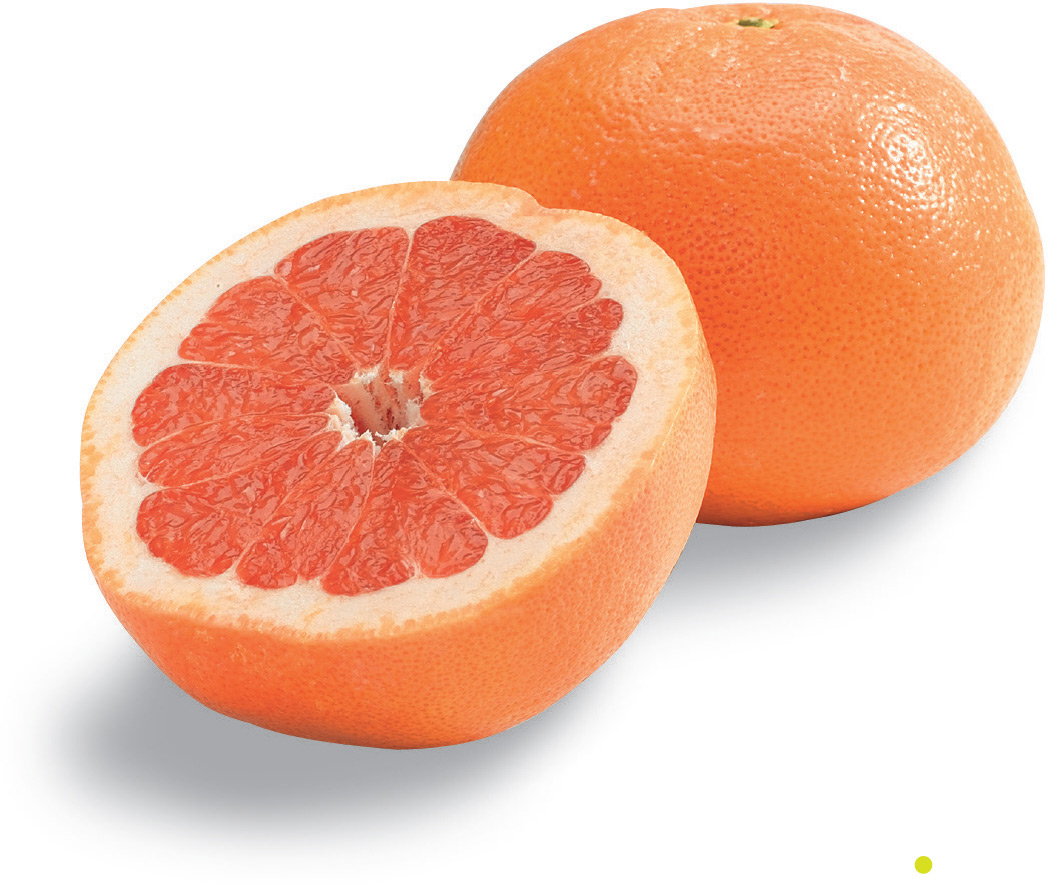
Anyone who has ever tried to lose weight has likely heard of the Mayo Clinic Diet, which has been passed around for more years than I can remember and which always features grapefruit at every meal followed by some bastardized (and not very good) version of the Atkins Diet.
Only trouble is this: The diet has nothing to do with the Mayo Clinic, was never associated with the Mayo Clinic, and is not endorsed by the Mayo Clinic. Nevertheless, some version of the Mayo Clinic Diet (also known as the grapefruit diet) has been around forever, and so has the legend that grapefruit helps people lose weight. Nutritionists like me have been telling people for eons that that’s simply not the case, but that grapefruit, being a whole food with enzymes and low calories and high volume, can certainly help fill you up and be part of any smart weight loss regimen.
Grapefruit Diet May Be Credible After All
Now it turns out we may have spoken too soon. A study from the division of endocrinology of the department of nutrition and metabolic research at the Scripps Clinic in La Jolla, California, published in the Journal of Medicinal Food, shows clearly that the grapefruit legend may have some science to back it up! The researchers wanted to study the effect of grapefruit on weight and on insulin resistance, a central feature of metabolic syndrome (and often of diabetes). They took ninety-one obese patients and divided them into four groups. Group one got grapefruit capsules before meals, group two got grapefruit juice, group three got half a grapefruit, and group four got a placebo (nothing). The placebo group lost about 1/3 of a pound (150 g), the grapefruit capsule group lost 1.1 pounds (500 g), the grapefruit juice group lost 1.3 pounds (590 g), and the real grapefruit folks lost 1.5 pounds (680 g). Overall, only the fresh grapefruit group reached “statistical significance,” but among those with metabolic syndrome, all three grapefruit groups lost significantly more weight. Insulin resistance was improved in everyone. The authors admitted that the mechanism isn’t understood, but that it would be prudent to include fresh grapefruit in a weight loss diet.
Why Smokers Should Eat More Grapefruit
Meanwhile, even if you’re not trying to lose weight, grapefruit’s still a good food.
Researchers at Texas A&M University showed that freeze-dried grapefruit pulp, like whole grapefruit, reduced the incidence of early colon cancer lesions in an animal model of the disease. Grapefruit juice may help reduce the risk of cancer in smokers. In a controlled study involving forty-nine smokers, researchers at the University of Hawaii found that drinking three 6-ounce (256 ml) glasses of grapefruit juice a day reduced the activity of a liver enzyme called CYP1A2 that is thought to activate cancer-causing chemicals found in tobacco smoke.
It’s reasonable to think that might be helpful for nonsmokers as well, because reducing the activity of an enzyme that activates cancer-causing chemicals is a good thing no matter where the chemicals come from! And speaking of cancer, grapefruits—depending on the species and harvest time—contain substances called limonoids, which inhibit the development of cancer in laboratory animals and in human breast cancer cells and reduce cholesterol. And red (and pink) grapefruit contains lycopene (see guava and tomatoes, a carotenoid that has been associated with reduced risk of prostate and other cancers.
Red or White?
Researchers in Israel found that a diet supplemented with red grapefruits was effective in lowering triglycerides, a blood fat that is a risk factor for heart disease. In this study, fifty-seven postoperative bypass patients with high triglycerides were divided into three groups. One group was given the standard heart-healthy diet, and the other two groups were given the identical diet but with the addition of either Israeli Jaffa red grapefruit or standard white grapefruit. Only the diet supplemented with the red grapefruit was effective in significantly lowering triglycerides. Those eating the red grapefruit also lowered their LDL (“bad” cholesterol) by 20 percent, more impressive given that all the subjects had previously failed to benefit from cholesterol-lowering drugs! “Red grapefruit is higher in antioxidants, which may explain the difference in health benefits,” said study author Shela Gorinstein, Ph.D.
Potential weight loss, cholesterol-lowering, and anticancer benefits aside—and those are big benefits to put aside—grapefruit is a good low-calorie source of potassium and vitamin C. It even has a drop of calcium and magnesium, 20 mg of phytosterols, and a gram or two of fiber. The red and pink varieties also have vitamin A, beta-carotene, and the aforementioned cancer-fighting lycopene.
Grapes
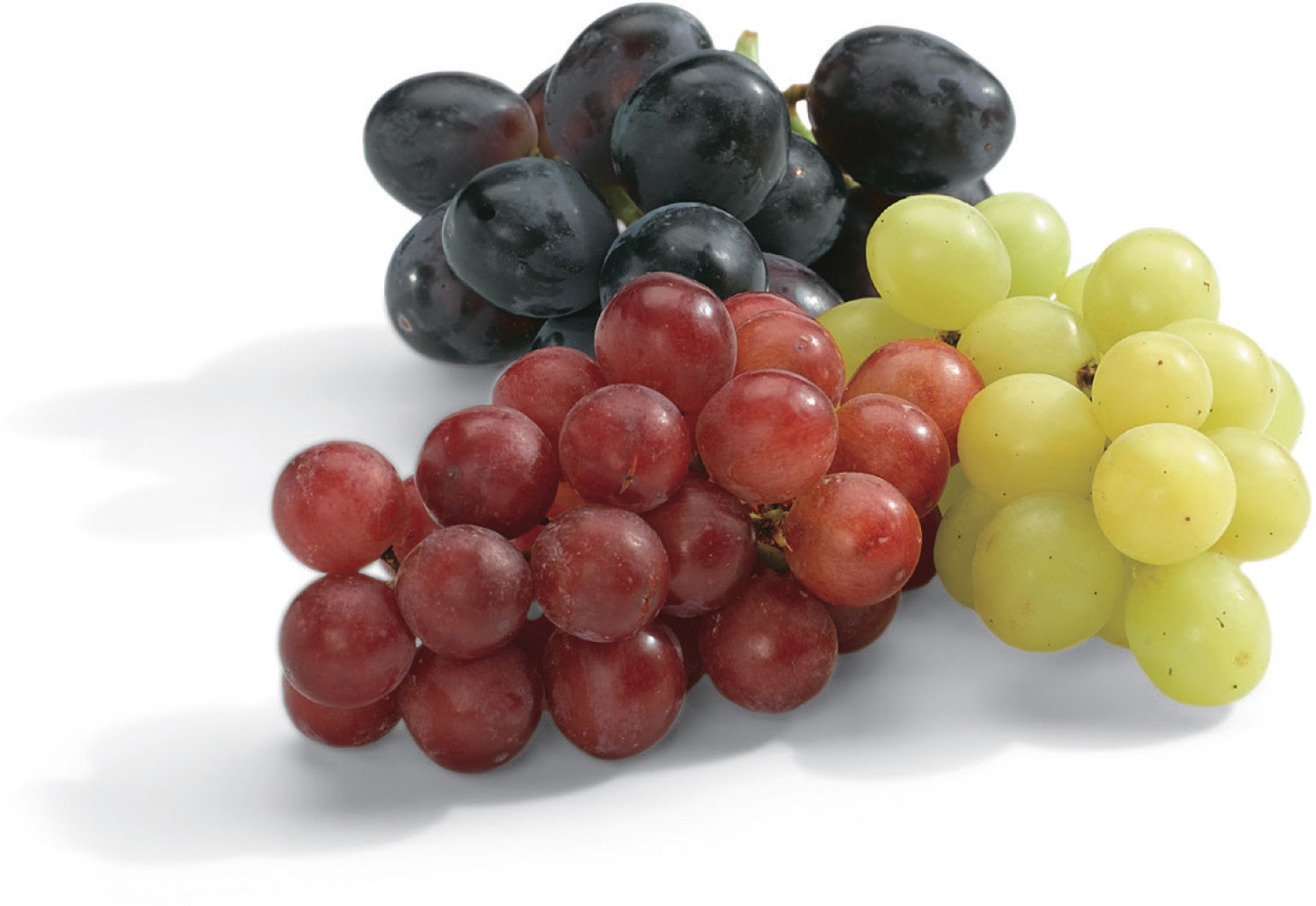
Grapes are one of my favorite desserts, but my secret is this: I freeze them. Don’t knock it till you try it. They taste like little balls of sherbet, and they’re the perfect munchy finger food for watching late-night reruns of Seinfeld.
Grapes are a whole pharmacy of healthful nutrients, many of which are potentially life extending. Take resveratrol. Resveratrol is a compound found in the skin of dark grapes and in the red wine that’s made from them. Resveratrol is usually credited for the health-promoting properties of red wine.
Technically, resveratrol belongs to a class of compounds called phytoalexins, which are chemical substances produced by plants as a defense against attack by pathogenic microorganisms. But resveratrol doesn’t just protect the plants that make it. In humans, high resveratrol intake is associated with a reduced incidence of cardiovascular disease and a reduced risk for cancer.
Scientists at the Illinois College of Pharmacy in Chicago found that resveratrol showed cancer-preventive activity in three major stages of tumor formation. Resveratrol also acted as an antimutagen, blocking other cell-changing agents from starting cancer. It’s also a powerful antioxidant, helping to protect cells against DNA-damaging free radicals.
Grapes Can Add Years to Your Life
Resveratrol may be one of the best antiaging substances around. Research by David Sinclair, Ph.D., says the life span of all life forms tested so far—yeast cells, fruit flies, worms, and mice—have been dramatically lengthened by minute amounts of resveratrol. That’s one of the reasons resveratrol is touted (by me among others) as one of the best antiaging supplements you can take. But you don’t have to take a supplement to get your daily dosage of this antiaging compound. Just make grapes a part of your diet! The skins of the dark (red, purple) grapes are the best source.
The benefits of grapes don’t stop with resveratrol. Grape seeds and skins are also a huge source of a class of flavonoids called oligomeric proanthocyanidins, or OPCs. Proanthocyanidins are powerful antioxidants—several times more potent than vitamins C and E. They help protect against the effects of internal and environmental stresses (cigarette smoking, pollution). Additionally, studies have shown that OPCs may prevent cardiovascular disease by counteracting the negative effects of high cholesterol on the heart and blood vessels. Physicians’ Desk Reference states that grape seed proanthocyanidins may be “cardioprotective,” a claim that was bolstered by a study from Spain showing that subjects who drank 100 ml of red grape juice every day for two weeks had significantly lowered LDL (“bad” cholesterol), increased HDL (“good” cholesterol), and decreased inflammatory markers.
And OPCs (proanthocyanidins) are terrific for allergies. According to Gina Nick, N.M.D., who has written in the alternative medicine newsletter Townshend Letter, on the use of OPCs for allergy symptom relief, OPCs found in grapes have a natural antihistamine effect.
Eat Grapes in Moderation
Many folks are concerned about the sugar in grapes, and yes, the carb count is moderately high if you’re watching your carbs. But the glycemic index is moderate, and much more important, the glycemic load—the only measure of sugar impact you need to worry about—is moderately low (under 10). The trick is not to overeat them, which is sometimes difficult. One cup (150 g) contains 106 calories—and one cup disappears quick! Grapes have small amounts of calcium and magnesium, vitamins C, A, and K, and a decent amount (294 mg) of potassium. I recommend eating them seeds and all. Too many amazing health-promoting compounds have been extracted from the seeds to throw them away.
A number of grape seed oil vendors have claimed that grape seed oil is high in OPCs (proanthocyanidins). However, independent studies have indicated that grape seed oil is the grape product with the lowest concentration of OPCs. I don’t recommend grape seed oil in any case. According to natural-foods expert Rebecca Wood, the toxins of a plant (like the toxins in an animal) are concentrated in its fat, and a plant’s fatty acids are concentrated in its seeds. Until someone makes an organic, unrefined grape seed oil free of the chemicals most commercial grapes are grown with, buying grape seed oil isn’t advised.
 Guava
Guava

Guavas are fragrant, delicious tropical fruits that many Americans know only because they’re frequently used in jellies. But these red-fleshed (and sometimes white-fleshed) fruits pack an amazing nutritional wallop. New government research demonstrates that guava may indeed deserve a place among the antioxidant elite. On one widely used test of antioxidant power called the ORAC test, guava beat out strawberries, spinach, and broccoli. Both the red and the white-fleshed types of guava scored in the top ten fruits and vegetables tested, but the red flesh had a higher antioxidant score.
Let’s start with the number-one-with-a-bullet reason why guava is such a superstar: lycopene.
Lycopene in Guava Fights Prostate and Breast Cancers
Guava has a higher concentration of the carotenoid lycopene than any other fruit or vegetable. Tomatoes are the main way Americans get their lycopene, but guavas are an even better source. A cup (165 g) of guava has 17 percent more lycopene than an equivalent amount of tomatoes. Why do we care? Consider this: In laboratory experiments, lycopene has been found to provide more protection against free radicals than any other member of the entire carotenoid family—and that includes beta-carotene!
And lycopene may save lives. It’s an antioxidant that, once absorbed by the body, helps prevent and repair damaged cells. Antioxidants are the internal bodyguards that protect our cells from DNA-damaging free radicals. The degenerative effects of free radicals include—but are not limited to—cancer. Free radicals can also cause blockages in the arteries, joint deterioration, nervous system degradation, and aging.
There is promising research showing that lycopene is associated with significant reduction in prostate cancer. As far back as 1995, the Journal of the National Cancer Institute published the results of a study conducted by Harvard University researchers that looked at the eating habits of more than 47,000 men between the ages of forty and seventy-five. They found that the men eating ten servings or more a week of high-lycopene tomatoes, tomato sauce, tomato juice, and even pizza had 45 percent fewer prostate cancers than men who ate fewer than two servings a week. In another study, done a few years later at the Karmanos Cancer Institute in Detroit, researchers gave lycopene supplements to thirty men who already had prostate cancer. Those given the lycopene supplements had smaller tumors and less spreading of the cancer. Best of all, the tumors in the participants who consumed lycopene supplements showed signs of regression and decreased malignancy.
Lycopene also inhibits the growth of breast cancer cells; in research, it has suppressed and delayed breast tumors in mice. And according to studies with Lithuanian and Swedish people, lower blood lycopene levels are also associated with increased risk of coronary heart disease.
Cooked or Uncooked, You Get All the Benefits of Guava
More lycopene is absorbed from cooked or processed tomatoes than from raw ones because their cell walls are tough and heat and processing breaks them down. According to my friend C. Leigh Broadhurst, Ph.D., of the USDA, the same isn’t true of guavas, whose cell walls are much less tough. Unlike tomatoes, you’ll get all the benefits of guava, the lycopene superstar, with or without cooking.
But it’s not just lycopene that makes guava a superstar. It’s also potassium. This fruit is a potassium heavyweight. One little cup (165 g) of guava cubes gives you a whopping 688 mg of potassium. Just for comparison, that’s 63 percent more than a medium banana! A ton of studies show that people who eat potassium-rich foods have lower rates of heart disease and stroke. Potassium is also a key component of healthy blood pressure. According to the latest studies, people who regularly consume high-potassium foods have lower blood pressure than those who don’t. A review of thirty-three studies examined the effect of potassium on blood pressure, and researchers discovered that participants who added 2,340 mg of potassium daily (from foods, supplements, or both) were able to lower their risk of developing high blood pressure by 25 percent. The reductions were ultimately greatest for people who already had high blood pressure. Another possible benefit of potassium: It may protect against stroke. One study found that people with high blood pressure who had a daily serving of potassium-rich foods (like figs) decreased their risk of fatal stroke by 40 percent.
Potassium Is Just the Beginning: Guava Is Also High in Fiber and Vitamin C
There’s just no end to what this fruit has to offer. It’s high in fiber. (In fact, if this fruit did nothing more than offer the amount of fiber it does, it might make the top 150 list on that alone.) The same 1 cup (165 g) of fruit we’ve been talking about delivers almost 9 g of fiber, making it a high-fiber food in anyone’s book. High-fiber diets have been associated with lower rates of cancer, heart disease, diabetes, and obesity, not to mention a healthier microbiome.
And if all that weren’t enough, 1 cup (165 g) of guava delivers an amazing 376 mg of vitamin C, making it a heavyweight in that department as well. Plus it offers 81 mcg of folate, a decent amount of calcium and magnesium, and a significant amount of vitamin A (1,030 IUs) and beta-carotene (617 mcg). Fruit really doesn’t get much better than this.
With all of these powerful nutrients, it is no wonder that a study from the Heart Research Laboratory in India demonstrated that people who ate five to nine guavas a day—about 2 to 3 cups (330 to 495 g)—for three months reduced their cholesterol levels by 10 percent, triglycerides by 8 percent, and blood pressure by 9.0/8.0 mm Hg, while boosting their “good” cholesterol (HDL) by 8 percent.
Honeydew
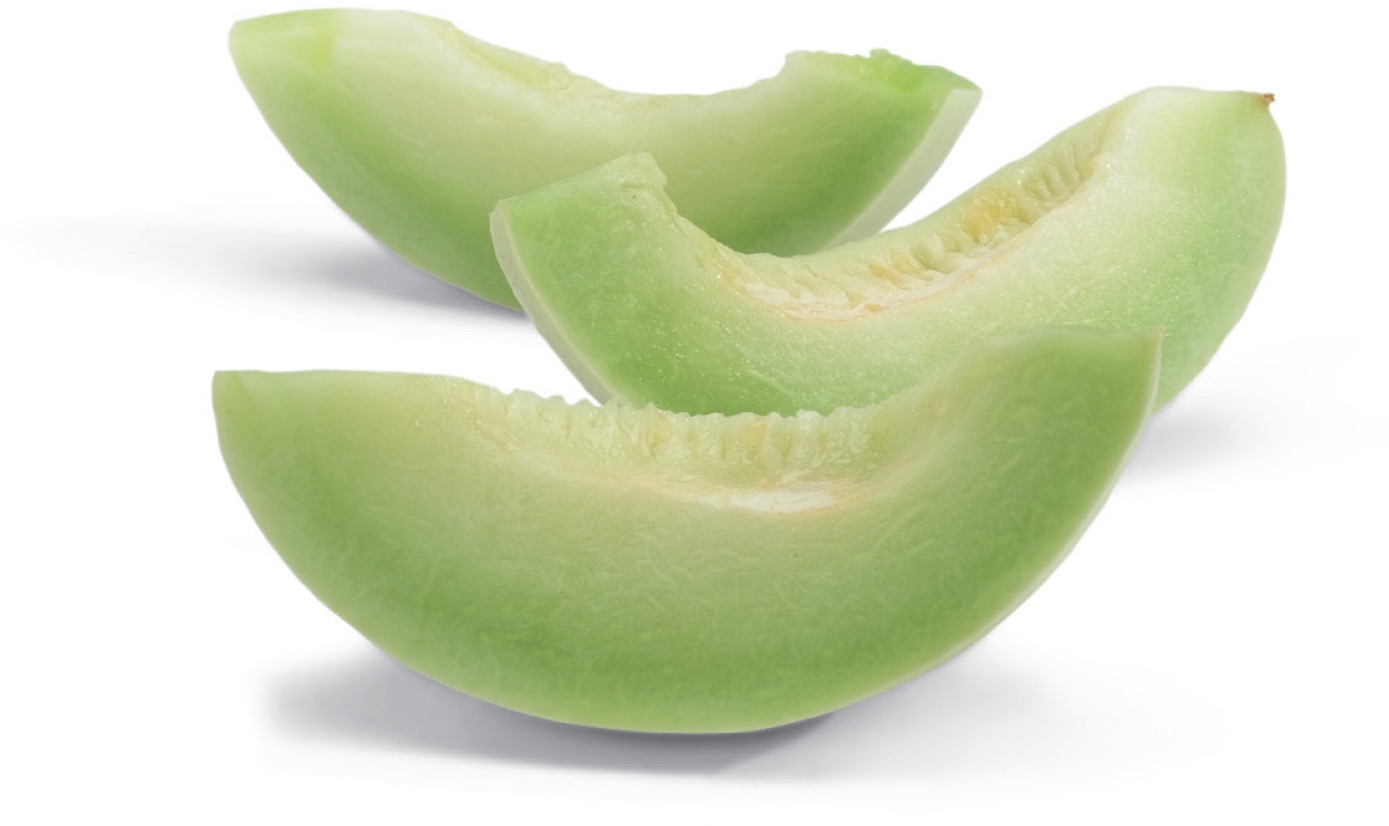
Honeydew melon may not be as loaded with vitamins and minerals as cantaloupe, but it’s still a high-volume food that’s both nutritious and potentially useful in a weight loss program.
Melons are high-volume foods. That means that for a given amount of weight, they contain a relatively high amount of water, fiber, and air (and a relatively low number of calories.)
Eat Honeydew to Control Your Appetite
Barbara Rolls, Ph.D., a nutrition researcher at Pennsylvania State University, has done a lot of research on appetite and appetite control. Rolls has found that people basically ate about 3 pounds (1.4 kg) of food a day, regardless of whether the food was high or low calorie. People stopped eating after consuming about 3 pounds (1.4 kg). They’d eat nearly identical servings of food (by weight), whether it was honeydew (high volume) or cheesecake (low volume). The subjects in her studies felt just as full after the low-calorie meals as they did after the calorie-rich meals—provided both meals contained the same volume of food.
Bottom line: Foods with high volume and low calories—that is, foods with a lot of water and fiber—are your best friend when it comes to weight loss.
Honeydew is truly a high-volume food. For goodness’ sake, an entire half melon has only 180 calories, less than most desserts. A typical serving is a wedge, or maybe a quarter of a melon. About 90 percent of the melon is water. But, as Rolls has shown in research study after research study, that water in the melon goes a long way toward filling you up. And, by the way—water in foods seems to do this more than water that you drink alongside foods. Hence melons and soups do a better job of appetite control than solid food plus a glass of water. No one really knows why.
But honeydew’s not a great food just because it’s high-volume and low-calorie, though that certainly gives it points. It’s also a potassium and vitamin A heavyweight. One little cup (165 g) of melon balls gives you a whopping 404 mg of potassium (not to mention a little calcium and magnesium and 31 mg of vitamin C). A ton of studies show that people who eat foods rich in potassium have lower rates of heart disease and stroke.
Potassium is also a key component of a healthy blood pressure. According to the latest studies, people who regularly consume high-potassium foods have lower blood pressure than those who don’t. A review of thirty-three studies examined the effect of potassium on blood pressure, and researchers discovered that participants who added 2,340 mg of potassium daily (from foods, supplements, or both) could lower their risk of developing high blood pressure by 25 percent. The reductions were ultimately greatest for people who already had high blood pressure. Another possible benefit of potassium: It may protect against stroke. One study found that people with high blood pressure who had a daily serving of potassium-rich foods decreased their risk of fatal stroke by 40 percent.
Honeydew also makes an amazing juice. Like cantaloupe and watermelon, it can be combined with other melons and sparkling water for a terrific summer cooler. Try adding ginger and mint to the mix.
Note: Crenshaw and casaba melons are similar nutritionally to honeydew. All are high in potassium; all have a little calcium, magnesium, and vitamin C; and all are mostly water, low in calories, and utterly delicious.
Jackfruit
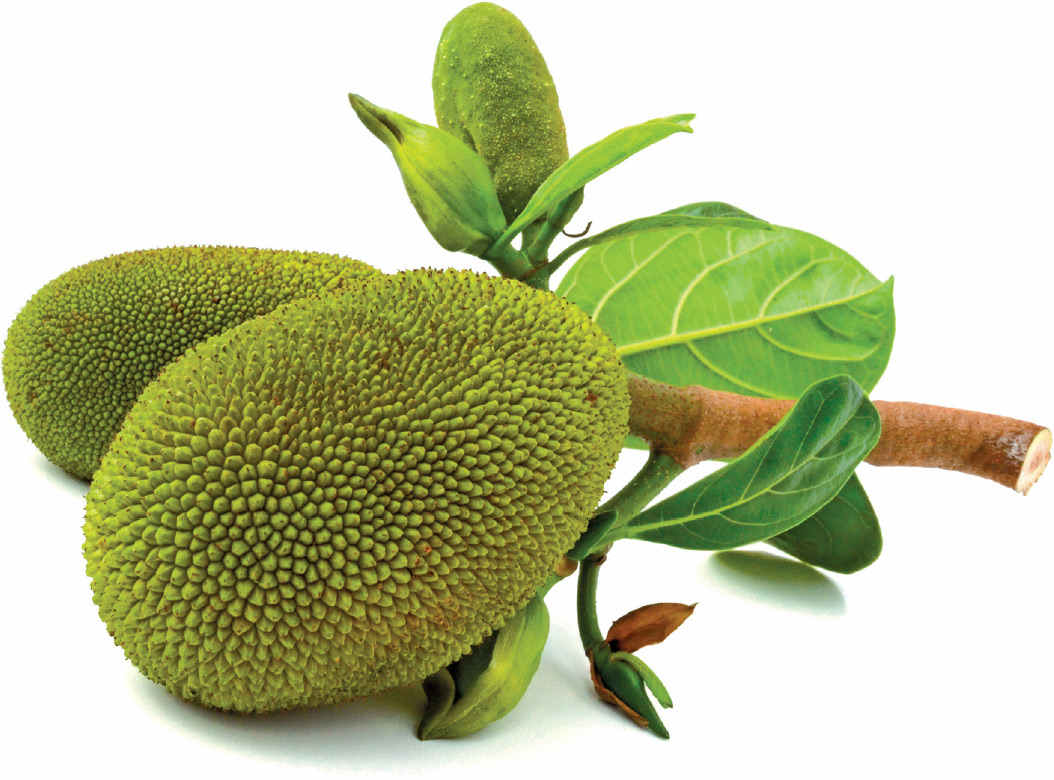
I wish I could tell you I discovered jackfruit the way my friend Chris Kilham (a.k.a the Medicine Hunter) would have, traipsing around the Brazilian rain forest with a machete searching for hidden sources of nutritional magic and medicine. But I found it in Whole Foods.
There it was sitting in a little plastic pouch, offering itself up as a new healthy snack and looking for all the world like dried papaya. I decided to try it, and I’m glad I did. The dried fruit sold in stores is chewy, sweet, fibrous, and delicious.
The fruit itself is huge. As in humongous. It’s the largest tree-borne fruit in the entire world, and it can weigh as much as 100 pounds. And while the fruit has a lot of vitamin C, it contains hundreds and hundreds of nutrient-rich seeds that have a lot of protein, calcium, potassium and iron. The fruit itself comes from South and Southeast Asia—in fact, it’s the national fruit in Bangladesh. And though you’ll almost never find it in the United States, you can sometimes get whole jackfruit in places such as Chinatown in New York City. (And packaged jackfruit snack in places like Whole Foods!)
The unripe fruits are green but turn light brown, gaining a strong, sweet fruity smell as they ripen. Jackfruit is high in fiber, and the fruit has a fair amount of vitamin A, beta-carotene, and lutein, all of which play crucial roles in vision. It’s also a good source of vitamin C, and is one of the rare fruits that are high in B-complex vitamins, especially B6, niacin, riboflavin, and folic acid. It’s also an excellent source of potassium, magnesium, manganese, and even iron. (Potassium is an important nutrient that helps control heart rate and blood pressure.)
Research shows that almost all parts of the jackfruit tree are used in preparations of many Ayurvedic and Unani medicines, and ripe fruits are eaten to prevent excessive bile formation, to strengthen the body, and to increase vitality. Medical practitioners in Sri Lanka and India use the leaves to treat diabetes. The roots, on the other hand, are useful for treating different types of skin diseases, asthma, and diarrhea. In Chinese medicine, jackfruit can potentially help with alcohol addiction.
Interesting factoid department: Though the jackfruit is prized in places like Bangladesh, it’s avoided in India, even though it could bring food to millions of starving, malnourished Indian citizens. Up to 75 percent of jackfruit grown in India goes to waste, largely because it has a bad reputation in India as a “poor man’s fruit.” It grows everywhere and is not particularly valued, and most of it goes to rot.
Everywhere else in Southeast Asia, jackfruit is a booming business. It makes its way into curry, stir-fry, chips, ice cream, baking flour made from the seeds… and, as I recently found out, into tasty little snack packs of dried fruit sold at Whole Foods. If you can find it, it’s worth trying. It’s both delicious and nutritious, and it lends itself to all kinds of imaginative dishes.
 Kiwifruit
Kiwifruit
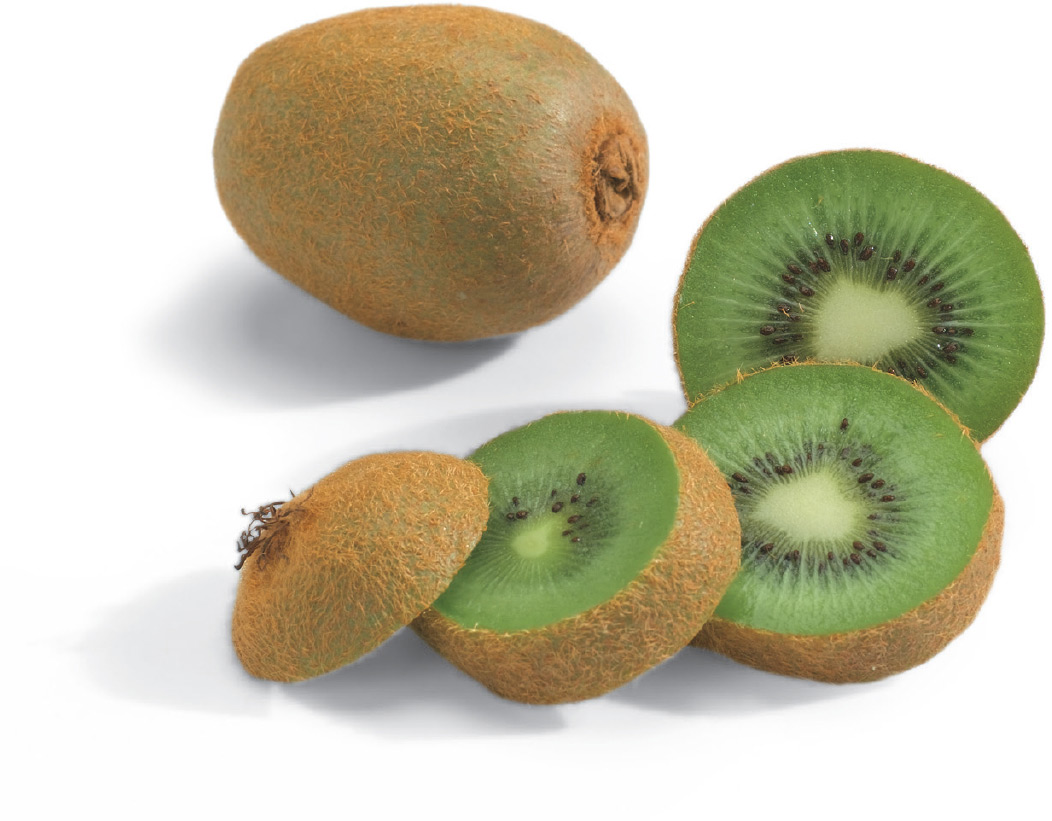
According to Dharma Singh Khalsa, M.D., the internationally acclaimed expert in integrative medicine and author of Food as Medicine, the kiwifruit is one of the most underrated healing foods. “Because of their rich array of disease-fighting antioxidants and phytonutrients, they are often prescribed in yoga nutritional therapy to help fight cancer and heart disease,” he says.
Kiwis Have Twice the Vitamin C of Oranges
I’m not surprised. A study conducted at Rutgers University in New Brunswick, New Jersey, evaluated the nutritional value of twenty-seven different fruits to determine, ounce for ounce, which provides the most nutrition. The results? Kiwifruit, with an index of 16, was found to be the most nutrient dense of all fruits. Second place was papaya at 14, and third place was a tie between mango and orange, which both scored 11. Kiwi has the highest level of vitamin C, almost twice that of an orange, and it is also a decent source of magnesium. Two medium kiwifruits have almost 5 g of fiber. And kiwi—along with papaya and apricot—outranked bananas and oranges as the top low-sodium, high-potassium food!
Another study in the Journal of Medicinal Food examined nine different fruits and fruit juices and reported that eight of them—including kiwi—exhibited significant ability to reduce oxidative stress (damage from free radicals) in human plasma. This ability of kiwi to protect against cellular damage was confirmed in yet another study in Carcinogenesis that was even more promising: In this Carcinogenesis study, not only did the kiwifruit limit the amount of oxidative damage to DNA, but it also stimulated cellular repair of the damage that did occur! Even better, the effect of kiwifruit on DNA damage and repair was seen when it was simply added to a normal diet, and the effects were seen across a whole group of volunteers and in a very short time!
Kiwi Works as a Blood Thinner, with None of Aspirin’s Side Effects
In research at the University of Oslo in Norway, kiwi has been shown to promote heart health by working as a blood thinner. This ability is important, considering how many people are told to take an aspirin a day for the same purpose. According to gastroenterologist and author of Optimal Digestion, Trent Nichols, M.D., daily aspirin can cause small breaks in the intestinal walls, contributing to all sorts of problems. In the Norway study, lead researcher Asim Duttaroy, Ph.D., noted that it was unlikely that kiwi would create any of the risk factors associated with aspirin such as stomach pain, excessive bruising, or bleeding. Kiwi also doesn’t disrupt the effects of any other medication. Can you imagine how great it would be to find natural food substances and supplements that accomplish the same cardiovascular protections as some medicines do, without any of the side effects?
Kiwifruits look like little brown furry eggs. They are native to China, though they’re now grown in Australia, New Zealand, and California. The little black seeds inside are edible, and the kiwi makes a great addition to fresh juice. If you juice them unpeeled, and with the seeds, they are rich in healthy enzymes.
Consumption of fresh fruits rich in vitamin C has been shown to be beneficial in protecting against respiratory symptoms associated with asthma and to help with wheezing symptoms in children. Kiwi has one of the highest vitamin C contents of any fruit.
Lemons/Limes
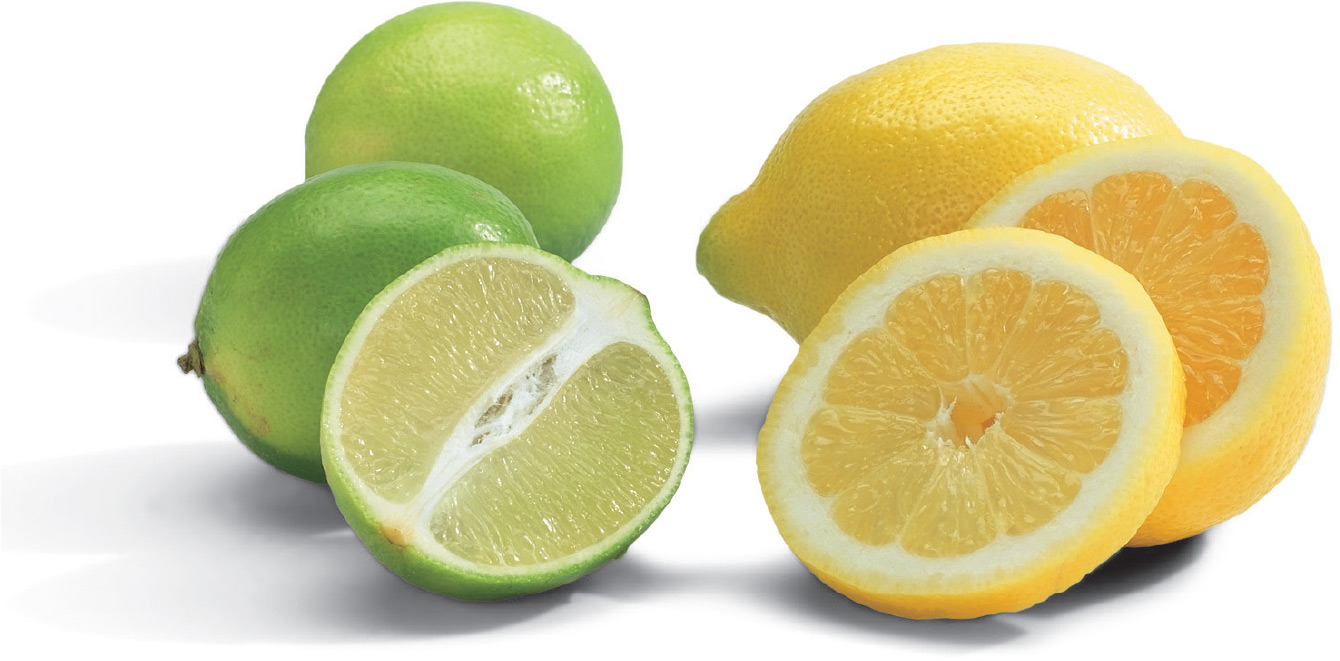
“When life gives you a lemon… squeeze it, mix with 6 ounces of water, and drink twice daily.” That folk wisdom was first reported by Jethro Kloss in his classic book, Back to Eden.
He was on to something.
Lemons
Lemons have been used in folk remedies for as long as anyone can remember, and the health benefits are now being documented in the science lab. (I love when that happens!) Back when I was a musician, I remember all the singers drinking hot water and lemon for their throats. My good friend Ann Louise Gittleman, Ph.D., C.N.S., has long used hot water and lemon as a staple in all her dietary programs, largely for its positive effects on the liver, the bile, and digestion. And according to naturopathic physician Andrew Rubman, N.D., half of a lemon daily raises the level of citrate in the body, which may help in fighting kidney stones.
Note: Other citrus juices do not have this effect; grapefruit juice has the opposite effect and should be avoided if you’re prone to kidney stones.
Lemon Peel and Hot Black Tea for Reduced Risk of Skin Cancer
Most of us know that lemons, like other citrus fruits, are a great source of vitamin C, a powerful antioxidant as well as an anti-inflammatory agent. For that reason alone, lemons would be a healthy fruit. But lemons also have been found to have two other compounds—a group of chemicals called limonoids, and specifically a compound called limonene, both of which have documented anticancer properties.
Limonene is found in the peel and has been shown in studies to be chemopreventive against mammary, liver, lung, and UV-induced skin cancer, and chemotherapeutic against mammary and pancreatic tumors. A study from the University of Arizona concluded that when citrus peel is consumed with hot black tea, the risk of skin cancer is reduced by 30 percent. (It’s amazing how these traditional combinations—tea and lemon, for example—keep being validated by science, isn’t it?). And it doesn’t take much limonene to get the value. According to the researchers, consuming 1 tablespoon (6 g) a week of the grated peel is all you really need to make a significant difference. One good idea: When making lemonade, use the whole fruit, including the peel! And don’t be afraid to make fresh juice with a juicer, using the whole fruit.
Limes Saved Lives
Back in the days when the maritime explorers started penetrating the Indian and Pacific Oceans, huge numbers of crew members were being lost to scurvy. Vasco da Gama lost two-thirds of his crew to the disease while making his way to India in 1499. Magellan lost 80 percent of his crew while crossing the Pacific. The symptoms of scurvy weren’t pretty: skin black as ink, ulcers, difficult respiration, teeth falling out, and perhaps most revolting of all, a strange mass of gum tissue sprouting out of the mouth. Not anything you’d want to have.
Now we know that scurvy was a vitamin deficiency disease, mainly of vitamin C, and sometimes compounded by an overdose of vitamin A from eating seals’ livers. Only when Captain James Cook of England insisted on feeding his crew sauerkraut and lime juice to fight scurvy (based on studies done by physician James Lind in 1747) did the death rate begin to go down. But it was not until 1795 that lime juice rations were provided for all sailors in the Royal Navy, and to this day, British sailors are known as “limeys.”
Limes don’t differ a lot from lemons in their nutritional value. They’re hardly a nutritional powerhouse, but they’re a good source of vitamin C, add a nice tart taste to foods and drinks, and can be substituted for lemons in most dishes.
Mangoes

Mangoes are known as the “king of fruit,” and it’s easy to understand why: They’re just plain delicious. They originated in Southeast Asia, where they have been grown for more than 4,000 years; legend has it that Buddha found tranquility in a mango grove. In India, the mango tree plays a sacred role: it’s a symbol of love, and some believe the tree can grant wishes. Many Southeast Asian kings and nobles had their own mango groves, which were a source of great pride and status. That’s where the custom of sending gifts of the choicest mangoes began.
Mangoes are a high-volume food, meaning they contain a high percentage of water, so you get a lot of food for a relatively few number of calories (135 for a whole mango). Mangoes have a lot of potassium, vitamin A, and beta-carotene, plus they have some vitamin C, vitamin K, calcium, phosphorus, and magnesium, as well as a smattering of other nutrients. They’re believed to be a rich source of enzymes, making them ideal to use as a tenderizing agent and perfect for marinades. And one mango contains more than 31/2 g of fiber.
Choosing the Best Mango
Picking out a mango to buy is pretty easy. The ripe ones have a full, fruity aroma coming from the stem end. When they’re slightly soft to the touch and yielding to gentle pressure, they’re considered ready to eat. The best way to ripen them is at room temperature, though you can hasten the process by putting them in a paper bag. Some folks put an apple in the bag with the mango because it further decreases the ripening time by creating more natural ethylene gas. They have the most flavor if you eat them at room temperature, though you can refrigerate them if you like.
Mangoes are another of the tropical fruits that got a bad reputation among the low-carb folks due to their sugar content. While it’s true that a whole mango contains 30 g of natural sugar, and people with blood sugar concerns may have to watch their intake of fruit, mangoes don’t actually have a very high glycemic load, weighing in at about 8 (under 10 is considered low, over 20 is considered high).
Mangosteen
(and Mangosteen Juice)
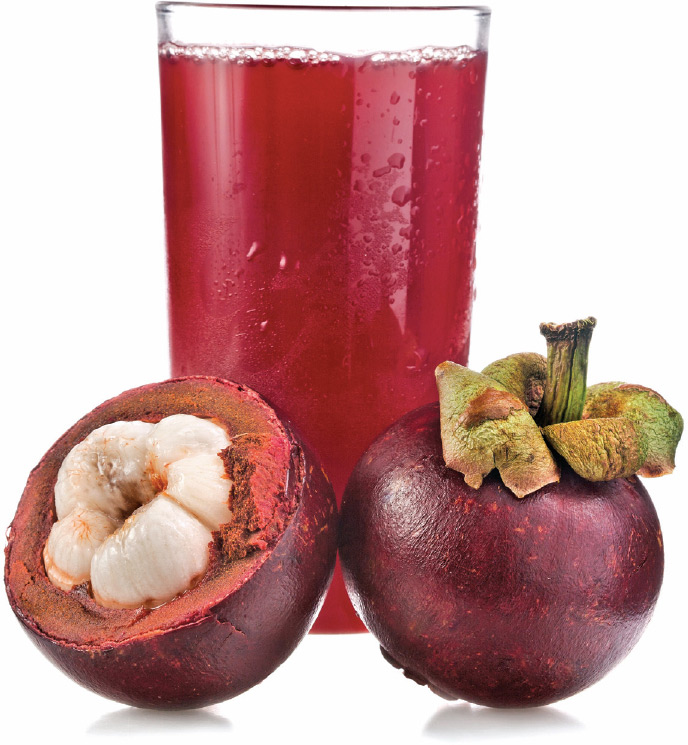
You won’t find mangosteen growing in the United States. But in Southeast Asia, it’s referred to as “the queen of fruits” and “the fruit of the gods.” That’s because on the islands of Southeast Asia—where it grows on a native evergreen tree it plays a central role in traditional medicine.
The rind of the fruit is rich in substances known as xanthones, which are naturally occurring plant chemicals. Xanthones—named for the Greek word for yellow—are a yellow pigment that can offer some protection against certain types of cancer. One review study on xanthones from mangosteen extracts noted that “Multiple lines of evidence from numerous in vitro and in vivo studies have confirmed that xanthones inhibit proliferation of a wide range of human tumor cell types.”
The problem is that the xanthones are found primarily in the rind, which no one eats, but some of the higher quality mangosteen juices are made from both the fruit and the rind (the pericamp), so theoretically you should get some xanthones in the better juices. Besides having anticancer effects, xanthones exhibit a wide range of biological activities—they’re both anti-inflammatory and antibacterial.
Aside from the xanthones, mangosteen (the fruit) contains a good amount of B-complex vitamins as well as minerals such as copper, manganese, magnesium and potassium. But the real selling point of the fruit (and specifically, the fruit juices) are the xanthones.
That’s an important point. The mangosteen fruit is still considered exotic in the United States, and they’re not exactly easy to find nor particularly popular. But mangosteen juice products have made a big splash, largely because of aggressive marketing and an almost insatiable need for the next big thing.
There’s no doubt that the scientific literature on xanthones is strong and promising, but that begs the question: how much xanthones make it into mangosteen juice products? Some juices may have a high-xanthones level, some may have a zero xanathones level. This doesn’t mean they’re bad. Mangosteen is a perfectly fine juice with a lot of good stuff in it, but it really doesn’t have anything you can’t get in other less exotic juices.
Tip: Look for mangosteen juice that’s made from both the mangosteen fruit and the pericarp. (The pericarp is the rind, where all the xanthones hang out.)
Oranges
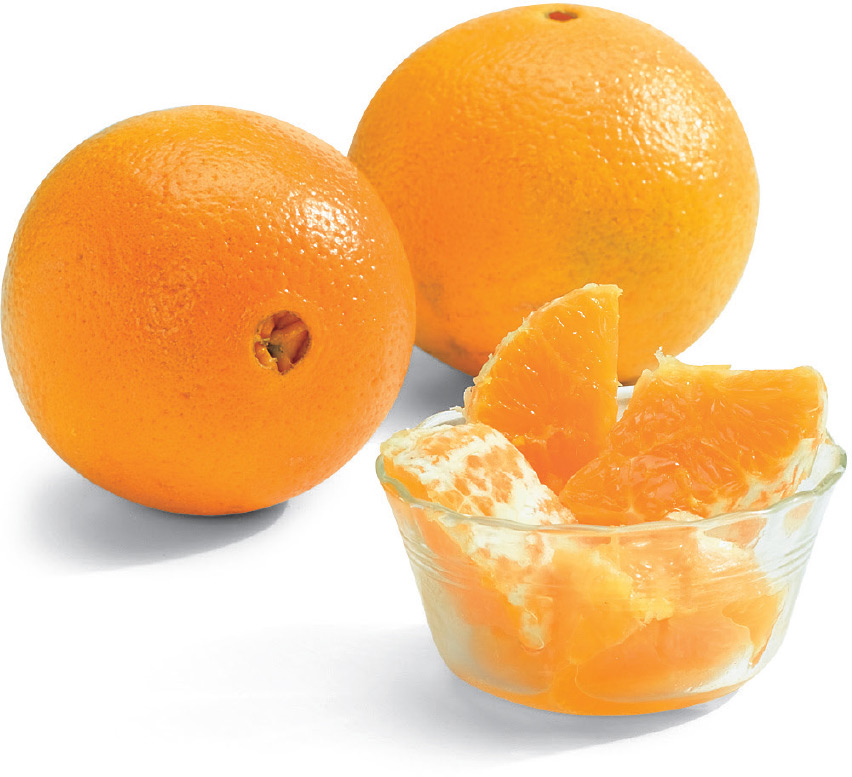
A few years ago, when the low-carb craze was sweeping the country, there were rumblings that an association of citrus growers was threatening to sue low-carb diet docs who were claiming that orange juice was not much more than sugar water. At the time, my book Living Low Carb was a bestseller, so Fox News asked me to be a talking head on one of their magazine shows, debating another talking head representing the orange growers.
On my way to the studio I picked up a well-known brand of “single serving” orange juice drink from the local 7-Eleven. Shortly after the “debate” began, I simply held the bottle up, and read the ingredients out loud. As I recall, the first two ingredients were water and sugar and the total carb (sugar) content was somewhere around 50 g. “But wait,” said my opponent. “Look how much better it is than soda!” “Better than soda?” I said. “Yes. Does that make it ‘good’? No. It makes it ‘better than soda.’”
Game over.
Orange Juice Can’t Compete with Whole Oranges
Don’t get me wrong. Real, squeezed orange juice isn’t all bad. In fact, the Harvard Nurses’ Health Study, which included more than 87,000 people, showed a 25 percent lower risk of stroke in those who drank one glass of orange juice a day, though those results may have been due to other healthy habits of the juice drinkers. And many of the cancer-fighting limonoids (see below) are also present in the juice. But compared to the whole fruit, orange juice is a second-class citizen and contributes far too much sugar to our diet; it doesn’t hold a candle to the health benefits of the whole orange.
So no, I’m not much of a fan of orange juice, especially not “orange juice drinks” (translation: sugar water with chemically created orange flavor). I am, however, a huge fan of oranges, for a host of reasons of which vitamin C is only the first. Vitamin C, of course, is one of the premier antioxidants on the planet, maintaining the health of cells and helping to protect them against damage from destructive molecules known as free radicals, which are linked to cancer, DNA damage, and aging. But though the orange is famous for its vitamin C content (63.5 mg per medium fruit), it actually has more than 170 cancer-fighting phytochemicals and 60 flavonoids, making it a complete package of health-promoting goodness.
Orange Therapy
Oranges contain limonoids, phytochemicals abundant in citrus fruit that account for the scent of fresh lemon and orange peels. (Many of the plants used in traditional healing, such as the neem plant, are rich in limonoids.) Currently limonoids are under investigation for a wide variety of therapeutic effects such as antiviral, antifungal, antibacterial, antineoplastic, and antimalarial. In laboratory tests with animals and with human cells, citrus limonoids have been shown to help fight cancers of the mouth, skin, lung, breast, stomach, and colon. And a metabolic by-product of these limonoids called limonin remains in the bloodstream for up to twenty-four hours, helping to explain some of its ability to fight cancer cells. Early research has speculated that limonin may help lower cholesterol—Agricultural Research Service scientists are now investigating its cholesterol-lowering ability.
In addition to limonoids, oranges have other polyphenols that have been shown to have a wide range of benefits. Hesperidin, for example, is the predominant flavonoid in oranges; it strengthens the capillaries and has anti-inflammatory, antiallergic, vasoprotective, and anticarcinogenic actions. Hesperidin works together with vitamin C to protect the heart, combat cancer, and fight infection. Together, these two powerful antioxidants also reduce the risk of stroke, lower high blood pressure, reduce inflammation, and improve cholesterol profiles.
Oranges also contain additional heart-health promoters, including blood pressure–lowering potassium, cholesterol-lowering pectin fibers, and homocysteine-lowering folate. Plus, the heart is protected by the orange-yellow carotenoid beta-cryptoxanthin. Numerous studies have shown that citrus fruits lower the risk of many cancers. To top it off, oranges contain calcium to promote strong bones and teeth. One medium orange also contains a nice 3.4 g of fiber, another benefit of eating the fruit instead of just drinking the juice.
Don’t Forget: Pulp Is Your Friend
The thing to remember is that a lot of these healthy compounds like the limonoids are found in the white stuff that surrounds the orange, or even in the peel. That’s another reason I prefer eating (or juicing) the whole orange. If you do juice, remember that the pulp is your friend—don’t throw it away. If you want to make orange juice and your juicer is one of those powerhouses that can handle it, throw the whole fruit in, peel and all. It’ll be a little tart, but you can handle it. Or try throwing a little of the peel in just to get used to the flavor. Even a little is better than nothing!
Papaya
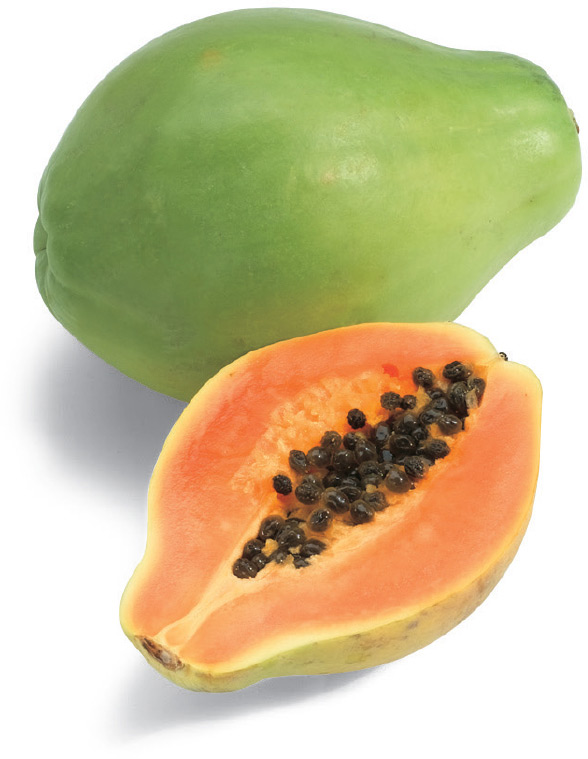
Papaya—along with pineapple—is one of the best sources of digestive enzymes. Papaya contains papain, an enzyme that helps break down or digest protein. Papain is often extracted from papaya and used in digestive enzyme supplements as well as in enzyme supplements that are used for pain (e.g., arthritis, sports injuries).
Papaya Enzymes Ease Digestion, Pain, and Inflammation
Papaya is a potassium heavyweight. One medium papaya has 781 mg of potassium and 119 calories, not to mention 5.5 mg of fiber. A cup (145 g) of cubed fruit has only 55 calories and still contains 360 mg of potassium, as well as 34 mg of calcium, 2.5 g of fiber, 86.5 mg of vitamin C, 53 mcg of folate, more than 1,500 IUs of vitamin A, 386 mcg of beta-carotene, and 105 mcg of the eye-protecting carotenoids lutein and zeaxanthin.
Figure there’s a little more than 2 cups (290 g) of fruit in one medium papaya. And papaya could easily be considered an immune system–building fruit because vitamin C and vitamin A are both needed for the proper function of a healthy immune system.
Reduce Your Lung Cancer Risk by 30 Percent
Papaya is also a great source of the lesser-known cousin of beta-carotene, beta-cryptoxanthin. (One medium fruit contains 2,313 mcg.) Studies have shown that beta-cryptoxanthin can reduce the risk of lung cancer by more than 30 percent. Other studies have shown that it reduces the risk for rheumatoid arthritis as well (by 41 percent in one study). It also appears to have strong antioxidant properties.
There are about fifty varieties of papayas, many of which are inedible and not sold commercially, and they can range from 8 ounces (225 g) to—believe it or not—20 pounds (9 kg). Most common commercial varieties, such as the Hawaiian Solo, are on the small side. Papayas with reddish flesh have a taste that differs from that of the orange-fleshed types, which are sweeter.
If you buy papayas green and firm, they will probably not ripen, but you can use them in cooking (they can be cooked like winter squash). For eating raw, choose fruit that’s free of black spots and skin damage. The spreading yellow color indicates that the fruit is softening and shows how far along it is in ripening. By the way, the black seeds inside are edible—they have a slightly bitter, peppery taste.
Peaches

Peaches are my idea of a nice, generic fruit. Maybe they’re not the nutritional superstar of the fruit community, but they sure meet all the requirements of a healthy food. Low calorie, 11/2 grams of fiber, small but measurable amounts of calcium, magnesium, phosphorus, vitamins C and K, plus not insignificant amounts of vitamin A, beta-carotene, and potassium. And peaches contain a little beta-cryptoxanthin, a carotenoid with some anticancer and anti-inflammatory properties. They even have a smattering of lutein and zeaxanthin, the carotenoids now considered the superstars of eye nutrition.
Not bad for a mere 38 calories per medium-size fruit. And just for good measure, they have a low glycemic load—a measure of the impact a food has on your blood sugar.
The New Superbreed of Peaches
In coming years, peaches may even reach superstar status, if researchers at the Texas Agricultural Experiment Station have anything to say about it. “The trend is to develop varieties that have more health benefits, because the public is becoming more health conscious and making decisions based on that,” said David Byrne, Ph.D., experiment station researcher who has been breeding peaches for about twenty years. “Twenty years ago, the [breeding] emphasis was on big and pretty. That’s still important, but now we are looking at quality and trying to develop peaches with better health benefits.” Peaches already rank high in some types of phytochemicals and have been shown to have good to excellent antioxidant activity, some antimicrobial activity, and good to excellent tumor growth inhibition activity.
Did I mention that they’re also delicious?
The peach originated in China, and the peach tree was the Tree of Life to the ancient Chinese. Both peaches and nectarines have to be picked ripe—they don’t ripen well after picking. You also have to be careful with them, as one small bruise and they’ll go bad. Clingstone peaches are ones in which the pit clings to the flesh; freestone peaches are ones where the pit breaks free.
Pineapple
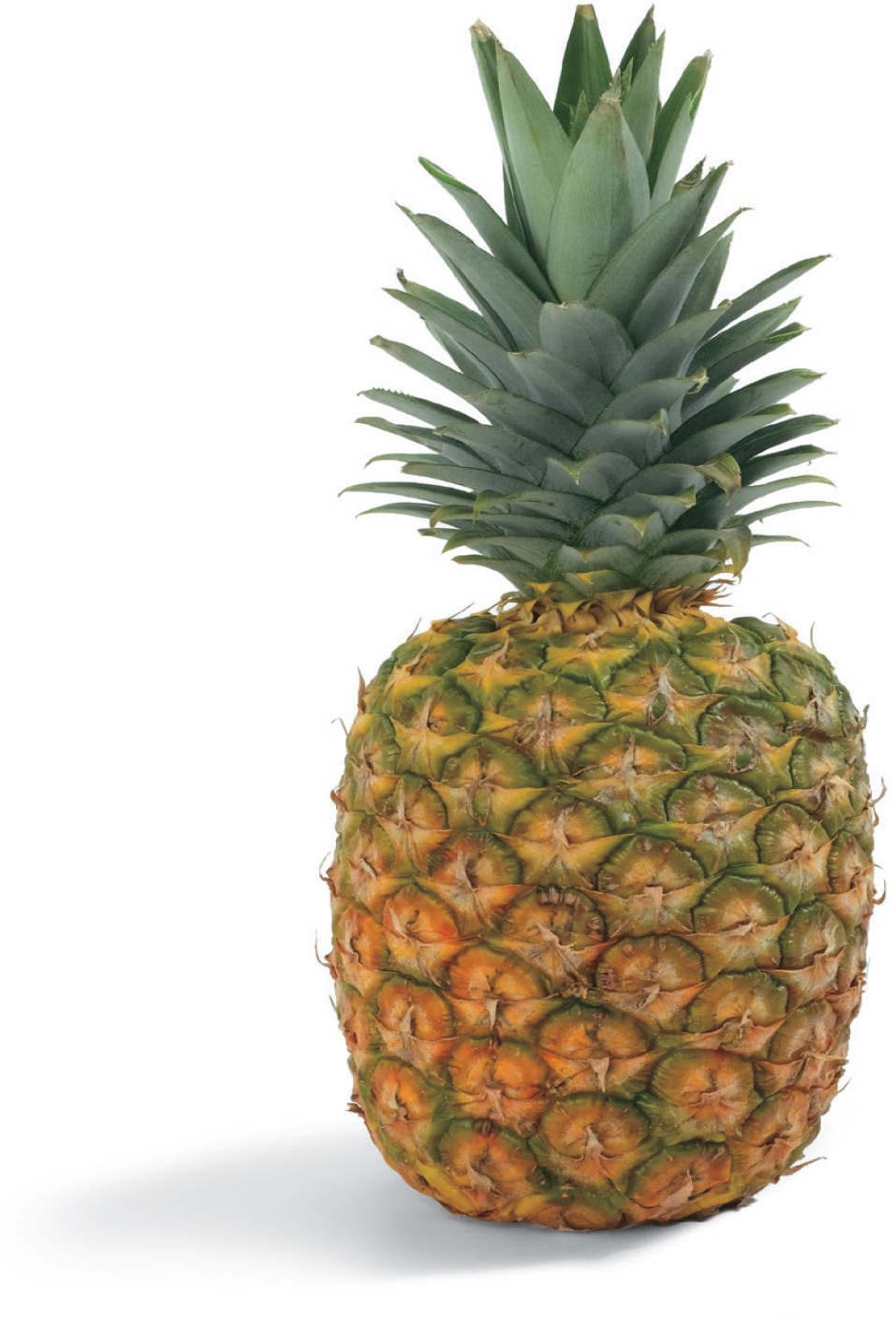
This delicious fruit not only looks healthy, but also it smells healthy. And most important, it is healthy. How can you miss?
Nutritionally, pineapple’s claim to fame is the fact that it contains bromelain, a rich source of enzymes that has many health benefits, including aiding digestion, speeding wound healing, and reducing inflammation. According to integrative medicine expert Andrew Weil, M.D., bromelain is effective in treating bruises, sprains, and strains by reducing swelling, tenderness, and pain. It’s also a natural blood thinner, as it prevents excessive blood platelet stickiness.
The Good Stuff Is in the Stem
Because it’s a group of powerful digestive enzymes, bromelain can relieve indigestion. A member of the class of enzymes known as proteolytic enzymes, bromelain breaks down the amino acid bonds in protein. It’s often extracted from pineapple and is a key ingredient in most over-the-counter digestive enzymes.
But—like many nutritive compounds found in our food—bromelaine may have multiple benefits, including some that are still being investigated. In research at the Queensland Institute of Medical Research in Australia, two molecules—CCS and CCZ—were extracted from bromelain and shown to have promise in fighting cancer growth. Lead researcher Tracey Mynott, Ph.D., said “…[W]e discovered that the CCS and CCZ proteins… could block growth of a broad range of tumor cells, including breast, lung, colon, ovarian, and melanoma.”
Remember that most of the extracts studied come from the inedible pineapple stem, (see below, under Worth Knowing).
A cup (165 g) of cubed fresh pineapple has almost 100 percent of the Daily Value for manganese, an essential trace mineral needed for healthy skin, bone, and cartilage formation, as well as for glucose tolerance. Manganese also helps activate an important antioxidant enzyme called superoxide dismutase (SOD). Depending on the variety, pineapple also has between 25 and 50 mg of vitamin C, plus a smattering of other vitamins and minerals, including potassium. One cup (165 g) contains about 2 g of fiber. And pineapple’s glycemic load—a measure of a food’s impact on your blood sugar—is relatively low.
Prunes

Okay, honest answer: What’s the first thing you think of when I say “prunes”? Half the people I know think of shuffleboard courts, retirement communities, and their ancient relatives sipping prune juice for regularity. But, truth be told, this is one delicious fruit, and one of the best and easiest ways to get soluble fiber into your diet. And don’t underestimate the whole idea of regularity—though it’s hardly sexy, regular healthy bowel movements are a very good indication of good digestion, and because the gut is ground zero for both the immune system and nutrient absorption, they’re more important for ultimate well-being than you might think.
Prunes Are the Dried Version of European Plums
All prunes come from plums, but not every variety of plum can become a prune. Prunes are actually the dried version of European plums. But juicy plums can’t morph into prunes—the fermentation will spoil them before they can dry.
You can thank the California gold rush for domestic dried plums (another term for prunes). Though plum trees have been cultivated since ancient times, they weren’t introduced to North America till 1856, by a Frenchman. When he failed miserably at mining gold, he planted plum trees, covering California with more than 90,000 acres of orchards over the next thirty-five years.
Prunes are high in fiber, which is beneficial in reducing the risk of colorectal cancer. Fiber is also important in reducing the risk factors for cardiovascular disease, breast cancer, diabetes, and diverticular disease. High-fiber diets are usually much more successful for weight loss than low-fiber diets.
Prunes are also a good source of vitamin A, vitamin C, potassium, and iron. They contain large amounts of phenolics, the general name for a huge and diverse group of plant compounds with numerous health benefits. The phenolics in prunes have high antioxidant activity. The two types of phytonutrients (nutrients from plants) found in plums and prunes, neochlorogenic acid and chlorogenic acid, are effective antioxidants, particularly effective against a very destructive free radical called the superoxide anion radical, which can really wreak havoc on the cells in your body.
Prunes Boast More Antioxidants Than Any Other Fruit
The damage-preventing substances in prunes have been shown to help prevent damage to fats. Our cell membranes and brain cells are largely composed of fats, and preventing free radical damage to fats is a significant benefit. Cholesterol is also a kind of fat, and in fact, is only a real danger to us when it gets oxidized (or damaged by free radicals) in the body. So anything helping to prevent this oxidation would be a very good thing. In actuality, prunes have the highest oxygen radical absorbance capacity (ORAC) of any food tested, which means that the compounds in prunes, working as a group, deliver more of a protective antioxidant punch than any other food tested. Prunes actually topped the ORAC list with more than twice the antioxidant capacity as other high-scoring fruits such as blueberries and raisins.
Raisins
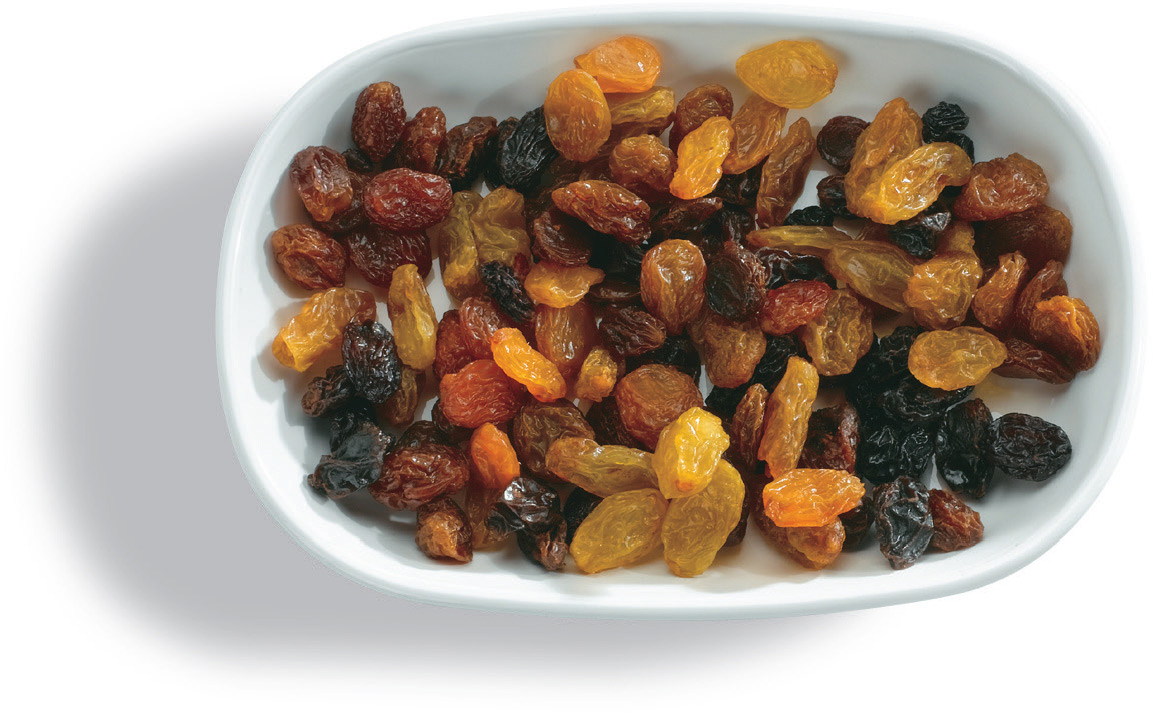
Raisins—like figs and dates—are known as nature’s candy. According to natural-foods expert Rebecca Wood, if you were to take 4 pounds (1.8 kg) of grapes and remove most of the water, you’d be looking at 1 pound (455 g) of raisins. Wood also points out one of the good things about raisins is that their transformation from grapes takes place via an old-fashioned drying process called the sun (hence the term “sun-dried raisins”), although some companies do it by a mechanical process of oven drying.
One caution about raisins from a pesticide and contamination point of view—they’re only as good as the grapes they come from. Since the raisins are basically concentrated grapes, they are believed to have the highest pesticide residue of any fruit. Which would be a good reason to go organic.
On the positive side, raisins are high in phenols, plant compounds that have repeatedly been shown to have antioxidant activity and to help prevent damage to cells in the body from destructive molecules called free radicals. University of Scranton scientists found that raisins (as well as prunes, dried apricots, and cranberries) scored higher in phenol content than their fresh counterparts.
In a study in the Journal of the American College of Nutrition, Harold Miller, Ph.D., and his colleagues analyzed the antioxidant content of cereals, fruits, and vegetables using a complicated scientific method that scores the foods in units called TEs (Trolox equivalents). The findings were surprising (Miller found that many popular vegetables tended to be relatively low in antioxidants). Of the fruits, his team found that red plums had the highest TE score (2200). Of the berries, blackberries won with 5500. Of the dried fruits, dates were highest at 6600 followed by good old raisins, weighing in at a whopping 6400! That’s a pretty darn high rating for antioxidant activity.
Raisins are also relatively high in boron, a mineral under scrutiny for the promotion of bone and joint health, particularly in women. In one study, twelve postmenopausal women were given a diet deficient in boron for 119 days, followed by a 48-day period in which they received 3-mg boron supplements daily. On the boron-deficient diet, the women experienced increased loss of both calcium and magnesium, but on the boron-supplemented diet the opposite was true. According to the Physicians’ Desk Reference, “Boron appears to be a very important partner with calcium metabolism and as such should be expected to play an important role in the prevention of osteoporosis.”
Raisins are also a source of the flavonoid myricetin, which may have anti-inflammatory activity. It may also inhibit beta-amyloid fibril formation, a key problem with Alzheimer’s disease.
Watermelon
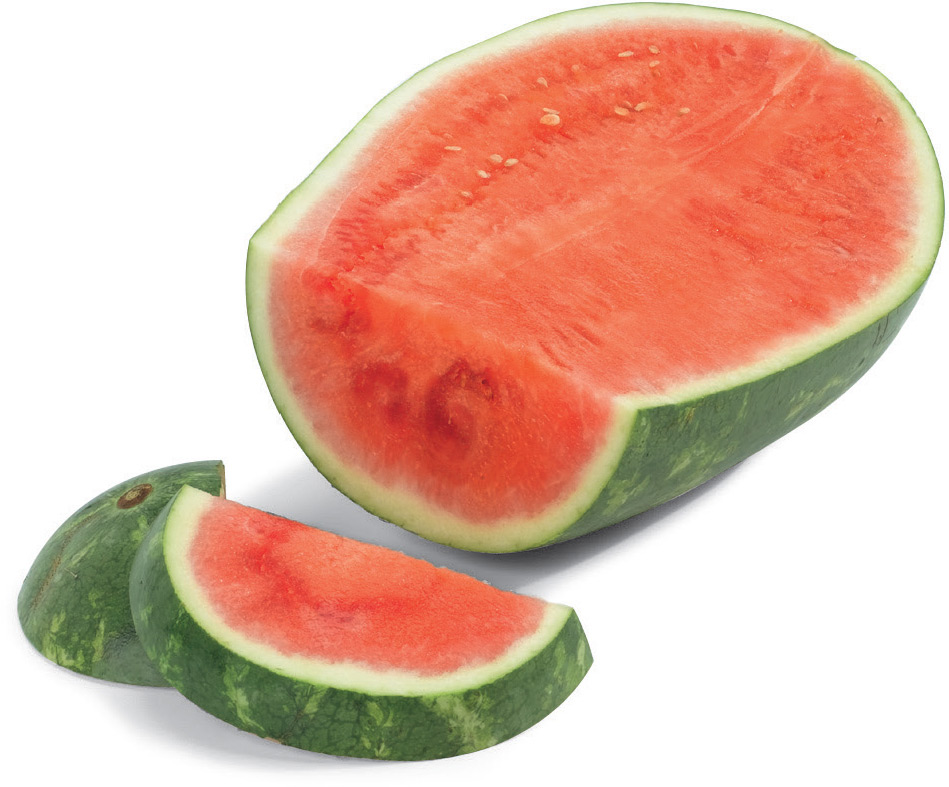
Watermelon owes its claim to fame as one of the world’s healthiest foods to three facts: One, its high water content (more about that in a moment); two, its high content of lycopene; and three, its high levels of vitamin A and carotenoids, including the important but relatively unknown carotenoid beta-cryptoxanthin.
Watermelon Is Extra Filling, Helps with Weight Loss
The fact that watermelon is mostly water falls squarely under the heading of “duh” for most people, but that’s a pretty important fact For years, Barbara Rolls, Ph.D., has been doing research at Pennsylvania State University on appetite, satiety, and weight loss. Her findings have been unequivocal: High-volume foods (defined as those that take up a lot of space for very few calories) are one of your best allies in the quest to lose weight. Watermelon is 92 percent water; it’s the very definition of a high volume food.
Rolls has found that water as part of food has a very satisfying—and filling—effect. For example, soup made of vegetables and water will fill people up and cause them to eat fewer calories than the same amount of vegetables eaten along with a glass of water. “When you add water to a bowl of vegetables as in soup, the soup has greater satiety than when the vegetables are eaten alone with a glass of water,” Rolls says. “When water is incorporated into food or shakes, satiety is increased and (people) ultimately eat less food.”
The Big Myth About Watermelon
In the low-carb world, watermelon is considered “fruit non grata.” It’s not that it’s not nutritious—you’ll read about that in a moment. Rather, it’s believed to be a very high-sugar fruit that you should stay away from if you’re trying to control blood sugar. Anti-watermelon folks point to the high glycemic index of the fruit (around 76), meaning that it raises blood sugar a lot and does it quickly. When you’re trying to control blood sugar and insulin—say you’re trying to lose weight or you’re just trying to get healthier—high blood sugar and high insulin are not something you want.
The truth is a little more complicated. The glycemic index is based on a “serving” of 50 grams of carbohydrate, not 50 grams of total weight. A 10-ball serving of watermelon is about 120 grams by weight, but it’s mostly water. There’s only 6 to 9 grams of carbohydrate in that serving. That’s why the glycemic load of watermelon—a far more meaningful and relevant measure of a food’s impact on blood sugar than glycemic index—is only about 4 (very low). The glycemic load takes into account portion size. So sure, if you ate 50 or 60 melon balls, you’d be closer to the amount of actual carbohydrate that was used in the study to determine glycemic index. But if you ate a normal, smallish portion of watermelon (i.e., the 10 balls), it would have minimal impact on your blood sugar.
The problem, of course, is, that it’s very easy to eat that 50-ball portion. I’ve known people who could knock off half a melon at one sitting (including myself!) But if you can keep the portion small, then the glycemic impact of this fruit is nowhere near what people think it is.
That said, for people who are extremely sugar sensitive, have metabolic challenges (i.e. metabolic syndrome, prediabetes, obesity or diabetes) and need to watch their sugar very carefully, this is probably not as good a choice as berries.
Lycopene in Watermelon May Reduce Risk of Prostate Cancer
But water, low calories and a low glycemic load (for a reasonable portion!) aren’t the only good things about watermelon. Watermelon is a great source of a carotenoid called lycopene, which in several studies has been shown to be associated with lower rates of prostate cancer. In one study, at the Karmanos Cancer Institute at Wayne State University, men facing surgery for prostate cancer were given 30 mg of lycopene for three weeks before undergoing surgery. The men who received the lycopene supplement had lower prostate-specific antigen (PSA) levels and less aggressive tumors than the nonsupplemented control group. Plus, their tumors were smaller.
Other studies have shown that people who eat lots of tomatoes and tomato products have less prostate cancer, a fact that has largely been attributed to the high lycopene content of tomatoes. And, in a review of seventy-two studies, one researcher reported fifty-seven associations between blood lycopene levels and reduced rates of cancer, thirty-five of which were statistically significant. The benefit was strongest for prostate, lung, and stomach cancers, although protective associations were also found for cancers of the pancreas, colon, rectum, esophagus, oral cavity, breast, and cervix.
Other researchers have pointed out that lycopene supplements may or may not give the desired effect. There’s good reason to think these incredible plant compounds work best when found in their natural surroundings along with other food ingredients (like other carotenoids). That’s another reason I like watermelon—it contains a nice supporting cast of other carotenoids and sources of vitamin A like beta-carotene and the less well-known beta-cryptoxanthin. In one study, beta-cryptoxanthin reduced the risk of lung cancer by 30 percent; in another study, it provided a 41 percent reduction in the risk of developing rheumatoid arthritis. And in rats, beta-cryptoxanthin has been found to have a bone-building effect.
High on Watermelon?
Interesting story: Medical doctor and yogi Dharma Singh Khalsa, M.D., sings the praises of watermelon as a detoxifier. Khalsa recounts a visit to Brazil in which he went on a watermelon fast: “After just three days I was very tuned in and meditating very deeply. This was one of the greatest highs I have ever experienced. When I boarded the plane for home, I was definitely in an altered state.”
Watermelon: low calorie, high volume, filling, satisfying, thirst quenching, and with a nice dose of vitamin A and carotenoids, including cancer-fighting lycopene. Plus it’s absolutely delicious. What’s not to like?
Fruit Runners-Up
Bitter Melon
Bitter melon is actually not a melon, but a cucumber-shaped summer squash grown in tropical areas such as Africa, Asia, and South America. It’s also known as balsam pear. By either name, it’s a great source of fiber, vitamin A, vitamin C, folate, magnesium, potassium, zinc, and manganese. But its real claim to fame is its ability to lower blood sugar.
Historically, bitter melon has been used to treat a whole assortment of conditions ranging from common infections to diabetes. In China, India, Sri Lanka, and the West Indies, bitter melon is widely used for diabetics. It actually contains a number of compounds that have proven antidiabetic properties, including a compound known as charantin. According to the highly respected naturopathic physician Michael Murray, N.D., charantin is more potent than the drug Tolbutamide, which has been used to lower blood sugar levels in diabetics. There are at least two other groups of constituents in bitter melon besides charantin—insulinlike peptides and alkaloids—that are reputed to have blood sugar–lowering effects. It’s not completely clear which of the three is most effective or if they all work together. Nonetheless, science has pretty much confirmed the blood sugar–lowering action of the fresh juice of the unripe bitter melon.
Usually, the bitter-flavored unripe fruit is used as a vegetable. It can be cooked a number of different ways, including stir-fried, steamed, and curried. Some enthusiasts recommend it as part of a vegetable curry with eggplants and onions. Cooking mellows its bitter flavor, which is due largely to the quinine content. Bitter melon is sold by many Asian grocery stores and is sometimes available frozen.
Pears
Fiber and potassium in a delicious package for about 100 calories—the same description that might apply to a banana applies equally well to a pear. One medium pear has a really hefty 5 g of fiber, plus about 200 mg of potassium; a smattering of other minerals such as calcium, phosphorus, and magnesium; 13 mg of phytosterols; and 75 mcg of eye-supporting lutein and zeaxanthin. Anjou, Bartlett, Bosc, and all the other varieties—including Asian pears—are pretty similar nutritionally.
When I was in New York hanging out with my friend the nationally known nutritionist and antiaging specialist Oz Garcia, Ph.D., he’d always make us detox drinks in a base of pear juice. While there’s no strong scientific evidence for this, many natural healers recommend pears and pear juice because they believe they’re less likely than other fruits to provoke any kind of allergenic response. I can’t prove that to you, but it seems to be the conventional wisdom. One of my favorite juice recipes is celery, pear, and ginger (see here).
If for no other reason, pears are a great food because of their high fiber content.
Persimmons
Here’s an interesting little factoid about persimmons that you might not know—assuming you knew anything about them in the first place, which not a lot of people do! The original “energy bar,” used by explorers and Native Americans, was something called pemmican. Pemmican is a huge favorite of the Paleo crowd—it’s basically dried meat (jerky) mixed with wild nuts and berries and pressed into a bar. It is quite tasty, by the way, especially when it’s made with grass-fed beef. And one of the main fruits used in pemmican is persimmon.
You can buy persimmons in the grocery store, and they come in two basic flavors: astringent and nonastringent. It’s important to know which one you’re getting. The astringent kind needs to be soft and ripe before eating, or else it tastes horrible. The reason for this is the presence of tannins, a group of chemicals that are also in red wine and tea. Once the fruit ripens and gets soft, the tannins become inert and the taste is no longer astringent. A cool way to ripen it quickly is to leave it in the freezer overnight and then allow it to thaw in the morning. If you’ve accidentally tasted one of these “before its time,” you might think this is the worst fruit on the planet, but give it another shot once it’s soft. Without the bitter tannins, it’s a whole different experience. The nonastringent kind, on the other hand, can be eaten firm or soft. Both kinds look like the plastic fruit you used to see on your grandmother’s dining room table, but they taste a lot better (unless, of course, you’re eating the astringent kind before it softens).
There are two basic varieties of persimmon: Hachiya (also called Japanese persimmon) and Fuyu. Hachiya is the most widely available persimmon in the United States, but it’s astringent, so remember to let it ripen. Fuyu are nonastringent, so you can eat them firm or soft. There’s also Sharon fruit (also called Israeli persimmon), which is round and sweet, and like Fuyu, can be eaten anytime.
PERSIMMON MAY LOWER BLOOD FATS
There are a couple of interesting studies on persimmons that are worth mentioning, even though they were done on rats. In one, a team of researchers led by Shela Gorinstein from Hebrew University of Jerusalem supplemented the diet of two groups of rats with added cholesterol. One group of rats was also fed supplemental persimmon. Now normally, when you feed rats cholesterol, their blood fats rise—but in the group fed the persimmon, the blood fats rose a lot less than expected. In fact, the rats with the persimmon-supplemented diet had much lower “bad” (LDL) cholesterol, triglycerides, and lipid peroxides (a measure of cellular damage caused by free radicals) than the rats that didn’t get the persimmon. The researchers concluded that persimmon possesses hypolipidemic properties (the ability to lower blood fats) as well as being a potent antioxidant (having the ability to protect against free radicals).
Both the persimmon pulp and the peel are good sources of fiber. A study published in Phytotherapy Research concluded that persimmon peel extract has potential therapeutic value as an antitumor agent. And persimmons have a number of carotenoids and polyphenols that have been shown to have health benefits. The fruit also contains potassium, magnesium, manganese, and iron.
Finally, an interesting study done in South Korea found that polyphenols isolated from the persimmon leaf had an antiwrinkle effect when applied to human skin. I’m not sure you get those same benefits by eating the fruit, but, as my grandmother used to say, “It couldn’t hurt.”
Quince
What if it wasn’t the apple that Eve used to tempt Adam?
Believe it or not, some historians think it might have been a quince. In fact, some people believe that a quince—not an apple—was the fruit that’s mentioned in the Song of Solomon. This makes sense, because the quince was actually cultivated before the apple and probably reached Palestine by 100 B.C.E.
While all that makes for nice folklore, the quince of today is hardly tempting to look at, and it is almost never eaten raw, especially in the United States where its tannin content gives it a very astringent, tart taste. (In western Asia and tropical countries, the fruit is softer and juicier.) So quince is one of the few fruits that’s almost always eaten cooked. But stewed or baked, it’s a whole different story: Cooking brings out its unique flavor and makes it a really nice addition to various meat recipes or sweet dishes. It also makes a terrific fruit sauce, similar in texture to applesauce.
Quince is high in pectin, a kind of soluble fiber that lowers cholesterol and also delays the absorption of glucose (sugar) into the bloodstream. A single quince has more than 11/2 g of fiber, plus 181 mg of potassium and 13 mg of vitamin C. While it’s not exactly a nutritional superstar, it’s a nice addition to your menu of healthy fruits to experiment with. The quince has a really powerful aroma, and if you leave it at room temperature, you’ll smell it for weeks. In ancient times they were used as room fresheners.
Star Fruit (Carambola)
This exotic-looking golden-yellow fruit, a native of Indonesia, is unique because each crosswise slice is a perfectly shaped star. The major producers include Taiwan, Malaysia, Guyana, India, Philippines, Australia, Israel, and the United States (Florida and Hawaii).
Two types of star fruit are grown, tart and sweet. Tart varieties typically have narrowly spaced ribs, while sweet varieties tend to have thick, fleshy ribs. The tastes between the two are not as distinct as you might think, because the tart variety still has some sweetness. The sweet star fruit can be eaten right out of your hand, used as a dessert, or thrown into a salad. The tart kind is a great substitute for lemon or lime. Truly a tropical fruit, it’s readily available from July through February, at least in the United States.
Star fruit is a good source of vitamin C (45 mg per cup [132 g]), potassium (176 mg per cup), and fiber. According to natural-foods expert Rebecca Wood, star fruit is cooling and astringent, clears excess heat, and is very good for diarrhea. It’s also low in calories.
According to research published in Food Chemistry and in the Journal of Chromatography, star fruit is a very good source of natural antioxidants. The major antioxidants present in the fruit’s extract are proanthocyanidins, most notably one called epicatechin, an antioxidant more commonly associated with green tea and red wine. That puts this lovely little fruit in very good company indeed.
THE EXPERTS’ TOP TEN LISTS
Barry Sears, Ph.D.
Barry Sears is the creator of the Zone Diet, and he is considered one of the leading authorities in the world on the hormonal response to food. He has written eleven books on his Zone technology, including the New York Times’ number-one best seller The Zone. A superb scientist and biochemist by training, Sears is resident of the nonprofit Inflammation Research Foundation that is conducting worldwide research on the role of diet in controlling chronic disease. His website, www.drsears.com, is consistently interesting and informative.
Sears was the impetus for my move from personal fitness training into nutrition. His theories and research about the hormonal impact of food—revolutionary back in 1995 and now accepted as conventional wisdom—moved me away from the high-carb, low-fat dogma of the 1980s and inspired me to go back to school for nutrition. He and I don’t agree on everything—egg yolks and soy being two examples—but I consider him one of the brightest and most dedicated people in the field.
1. Wild salmon: This is great source of omega-3 fatty acids coupled with great taste.
2. Chicken breast: This is standard low-fat protein that goes with everything.
3. Egg whites: These are a convenient source of low-fat protein that can be added to any meal to balance carbohydrates. A great snack is a couple of hard-boiled eggs in which the egg yolk has been removed and replaced with hummus.
4. Broccoli/cauliflower: Both are rich in fiber, vitamins, and minerals, with the least amount of carbohydrates. Cooking cauliflower, then mashing it up and baking, makes a great substitute for mashed potatoes.
5. Spinach: This powerhouse of vitamins and minerals can be sautéed with olive oil for a healthy carbohydrate source.
6. Red peppers: There is no better way to add color to a plate than red peppers. They’re loaded with antioxidants and protective phytochemicals, not to mention fiber.
7. Barley/oatmeal: These two great grains are rich in soluble fiber that slows the entry of any carbohydrate into the bloodstream.
8. Black beans: These provide another great source of soluble fiber.
9. Berries: This is the best dessert known. They’re rich in antioxidants, and they taste great, too.
10. Extra-virgin olive oil: This is number one favorite fat, as it contains powerful antioxidants known as polyphenols. Making a béarnaise or hollandaise sauce with olive oil instead of butter is a great way to make any vegetable taste better.
